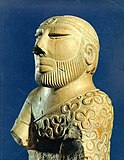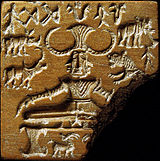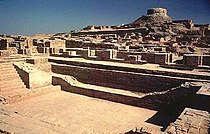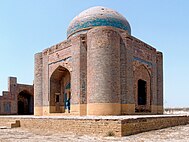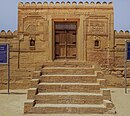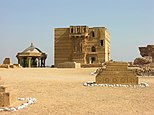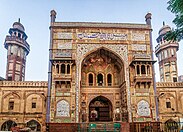History of Pakistan
| History of Pakistan |
|---|
 |
| Timeline |
| Part of a series on the |
| Culture of Pakistan |
|---|
 |
| Traditions |
| folklore |
| Sport |
| History of South Asia |
|---|
 |

The History of Pakistan prior to its independence in 1947 spans several millennia and covers a vast geographical area known as the Greater Indus region.[1] Anatomically modern humans arrived in what is now Pakistan between 73,000 and 55,000 years ago.[2] Stone tools, dating as far back as 2.1 million years, have been discovered in the Soan Valley of northern Pakistan, indicating early hominid activity in the region.[3] The earliest known human remains in Pakistan are dated between 5000 BCE and 3000 BCE.[4] By around 7000 BCE, early human settlements began to emerge in Pakistan, leading to the development of urban centres such as Mehrgarh, one of the oldest in human history.[5][6] By 4500 BCE, the Indus Valley Civilization evolved, which flourished between 2500 BCE and 1900 BCE along the Indus River.[7] The region that now constitutes Pakistan served both as the cradle of a major ancient civilization and as a strategic gateway connecting South Asia with Central Asia and the Near East.[8][9]
Situated on the first coastal migration route of Homo sapiens out of Africa, the region was inhabited early by modern humans.[10][11] The 9,000-year history of village life in South Asia traces back to the Neolithic (7000–4300 BCE) site of Mehrgarh in Pakistan,[12][13][14] and the 5,000-year history of urban life in South Asia to the various sites of the Indus Valley Civilization, including Mohenjo Daro and Harappa.[15][16]
Following the decline of the Indus valley civilization, Indo-Aryan tribes moved into the Punjab from Central Asia originally from the Pontic-Caspian Steppe in several waves of migration in the Vedic Period (1500–500 BCE), bringing with them came their distinctive religious traditions and Practices which fused with local culture.[17] The Indo-Aryans religious beliefs and practices from the Bactria–Margiana culture and the native Harappan Indus beliefs of the former Indus Valley Civilisation eventually gave rise to Vedic culture and tribes.[18][note 1] Most notable among them was Gandhara civilization, which flourished at the crossroads of India, Central Asia, and the Middle East, connecting trade routes and absorbing cultural influences from diverse civilizations.[20] The initial early Vedic culture was a tribal, pastoral society centred in the Indus Valley, of what is today Pakistan. During this period the Vedas, the oldest scriptures of Hinduism, were composed.[note 2]
The ensuing millennia saw the region of present-day Pakistan absorb many influences represented among others in the ancient, mainly Hindu-Buddhist, sites of Taxila, and Takht-i-Bahi, the 14th-century Islamic-Sindhi monuments of Thatta, and the 17th-century Mughal monuments of Lahore. In the first half of the 19th century, the region was appropriated by the East India Company, followed, after 1857, by 90 years of direct British rule, and ending with the creation of Pakistan in 1947, through the efforts, among others, of its future national poet Allama Iqbal and its founder, Muhammad Ali Jinnah. Since then, the country has experienced both civilian democratic and military rule, resulting in periods of significant economic and military growth as well as those of instability; significant during the latter, was the 1971 secession of East Pakistan as the new nation of Bangladesh.[citation needed]
Prehistory
[edit]Paleolithic period
[edit]The Soanian is archaeological culture of the Lower Paleolithic, Acheulean. It is named after the Soan Valley in the Sivalik Hills, near modern-day Islamabad and is dated between c.774,000 and c.11,700 BCE.[22]
Neolithic period
[edit]Mehrgarh is an important neolithic site discovered in 1974, which shows early evidence of farming and herding,[23] and dentistry.[24] The site dates back to 7000–5500 BCE and is located on the Kachi Plain of Balochistan. The residents of Mehrgarh lived in mud brick houses, stored grain in granaries, fashioned tools from copper, cultivated barley, wheat, jujubes and dates, and herded sheep, goats and cattle. As the civilization progressed (5500–2600 BCE) residents began to engage in crafts, including flint knapping, tanning, bead production, and metalworking. The site was occupied continuously until 2600 BCE,[25] when climatic changes began to occur. Between 2600 and 2000 BCE, region became more arid and Mehrgarh was abandoned in favor of the Indus Valley,[26] where a new civilization was in the early stages of development.[27]
Bronze age
[edit]Indus Valley Civilisation
[edit]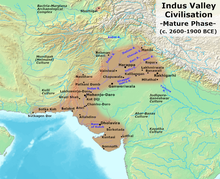
The Bronze Age in the Indus Valley began around 3300 BCE with the Indus Valley Civilization.[28] Along with Ancient Egypt and Mesopotamia, it was one of three early civilizations of the Old World, and of the three the most widespread,[29] covering an area of 1.25 million km2.[30] It flourished in the basins of the Indus River, in what is today the Pakistani provinces of Sindh, Punjab and Balochistan, and along a system of perennial, mostly monsoon-fed, rivers that once coursed in the vicinity of the seasonal Ghaggar-Hakra River in parts of north-west India.[28] At its peak, the civilization hosted a population of approximately 5 million spread across hundreds of settlements extending as far as the Arabian Sea to present-day southern and eastern Afghanistan, and the Himalayas.[31] Inhabitants of the ancient Indus river valley, the Harappans, developed new techniques in metallurgy and handicraft (carneol products, seal carving), and produced copper, bronze, lead, and tin.
The Mature Indus civilisation flourished from about 2600 to 1900 BCE, marking the beginning of urban civilisation in the Indus Valley. The civilisation included urban centres such as Harappa, Ganeriwala and Mohenjo-daro as well as an offshoot called the Kulli culture (2500–2000 BCE) in southern Balochistan and was noted for its cities built of brick, roadside drainage system, and multi-storeyed houses. It is thought to have had some kind of municipal organisation as well.
During the late period of this civilisation, signs of a gradual decline began to emerge, and by around 1700 BCE, most of the cities were abandoned. However, the Indus Valley Civilisation did not disappear suddenly, and some elements of the Indus Civilisation may have survived. Aridification of this region during the 3rd millennium BCE may have been the initial spur for the urbanisation associated with the civilisation, but eventually also reduced the water supply enough to cause the civilisation's demise, and to scatter its population eastward. The civilization collapsed around 1700 BCE, though the reasons behind its fall are still unknown. Through the excavation of the Indus cities and analysis of town planning and seals, it has been inferred that the Civilization had high level of sophistication in its town planning, arts, crafts, and trade.[32]
Early history – Iron Age
[edit]Vedic period
[edit]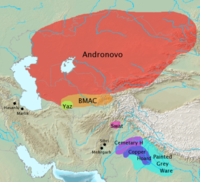
The Vedic Period (c. 1500 – c. 500 BCE) is postulated to have formed during the 1500 BCE to 800 BCE. As Indo-Aryans migrated and settled into the Indus Valley, along with them came their distinctive religious traditions and practices which fused with local culture.[17] The Indo-Aryans religious beliefs and practices from the Bactria–Margiana Culture and the native Harappan Indus beliefs of the former Indus Valley Civilisation eventually gave rise to Vedic culture and tribes.[33][note 3] Early Indo-Aryans were a Late Bronze Age society centred in the Punjab, organised into tribes rather than kingdoms, and primarily sustained by a pastoral way of life. During this period the Vedas, the oldest scriptures of Hinduism, were composed.[note 4]
Ancient history
[edit]Achaemenid Empire
[edit]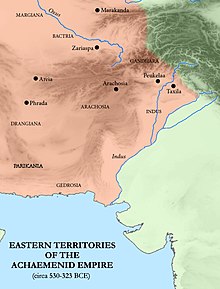

The main Vedic tribes remaining in the Indus Valley by 550 BC were the Kamboja, Sindhu, Taksas of Gandhara, the Madras and Kathas of the River Chenab, Mallas of the River Ravi and Tugras of the River Sutlej. These several tribes and principalities fought against one another to such an extent that the Indus Valley no longer had one powerful Vedic tribal kingdom to defend against outsiders and to wield the warring tribes into one organized kingdom. King Pushkarasarin of Gandhara was engaged in power struggles against his local rivals and as such the Khyber Pass remained poorly defended. King Darius I of the Achaemenid Empire took advantage of the opportunity and planned for an invasion. The Indus Valley was fabled in Persia for its gold and fertile soil and conquering it had been a major objective of his predecessor Cyrus the Great.[34] In 542 BC, Cyrus had led his army and conquered the Makran coast in southern Balochistan. However, he is known to have campaigned beyond Makran (in the regions of Kalat, Khuzdar and Panjgur) and lost most of his army in the Gedrosian Desert (speculated today as the Kharan Desert).
In 518 BC, Darius led his army through the Khyber Pass and southwards in stages, eventually reaching the Arabian Sea coast in Sindh by 516 BC. Under Persian rule, a system of centralized administration, with a bureaucratic system, was introduced into the Indus Valley for the first time, establishing several satrapies: Gandāra around the general region of Gandhara, Hindush around Punjab and Sindh, Arachosia, encompassing parts of present-day Khyber Pakhtunkhwa, and Balochistan,[35] Sattagydia around the Bannu basin,[36] and Gedrosia covering much of the Makran region of southern Balochistan.[37]
What is known about the easternmost satraps and borderlands of the Achaemenid Empire is alluded to in the Darius inscriptions and from Greek sources such as the Histories of Herodotus and the later Alexander Chronicles (Arrian, Strabo et al.). These sources list three Indus Valley tributaries or conquered territories that were subordinated to the Persian Empire and made to pay tributes to the Persian Kings.[36]
Macedonian Empire
[edit]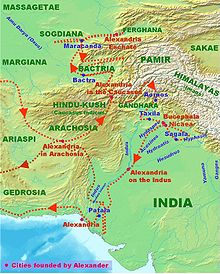

By spring of 326 BC, Alexander began on his Indus expedition from Bactria, leaving behind 3500 horses and 10,000 soldiers. He divided his army into two groups. The larger force would enter the Indus Valley through the Khyber Pass, just as Darius had done 200 years earlier, while a smaller force under the personal command of Alexander entered through a northern route, possibly through Broghol or Dorah Pass near Chitral. Alexander was commanding a group of shield-bearing guards, foot-companions, archers, Agrianians, and horse-javelin-men and led them against the tribes of the former Gandhara satrapy.
The first tribe they encountered were the Aspasioi tribe of the Kunar Valley, who initiated a fierce battle against Alexander, in which he himself was wounded in the shoulder by a dart. However, the Aspasioi eventually lost and 40,000 people were enslaved. Alexander then continued in a southwestern direction where he encountered the Assakenoi tribe of the Swat & Buner valleys in April 326 BC. The Assakenoi fought bravely and offered stubborn resistance to Alexander and his army in the cities of Ora, Bazira (Barikot) and Massaga. So enraged was Alexander about the resistance put up by the Assakenoi that he killed the entire population of Massaga and reduced its buildings to rubble – similar slaughters followed in Ora.[38] A similar slaughter then followed at Ora, another stronghold of the Assakenoi. The stories of these slaughters reached numerous Assakenians, who began fleeing to Aornos, a hill-fort located between Shangla and Kohistan. Alexander followed close behind their heels and besieged the strategic hill-fort, eventually capturing and destroying the fort and killing everyone inside. The remaining smaller tribes either surrendered or like the Astanenoi tribe of Pushkalavati (Charsadda) were quickly neutralized where 38,000 soldiers and 230,000 oxen were captured by Alexander.[39] Eventually Alexander's smaller force would meet with the larger force which had come through the Khyber Pass met at Attock. With the conquest of Gandhara complete, Alexander switched to strengthening his military supply line, which by now stretched dangerously vulnerable over the Hindu Kush back to Balkh in Bactria.
After conquering Gandhara and solidifying his supply line back to Bactria, Alexander combined his forces with the King Ambhi of Taxila and crossed the River Indus in July 326 BC to begin the Archosia (Punjab) campaign. His first resistance would come at the River Jhelum near Bhera against King Porus of the Paurava tribe. The famous Battle of the Hydaspes (Jhelum) between Alexander (with Ambhi) and Porus would be the last major battle fought by him. After defeating Porus, his battle weary troops refused to advance into India[40] to engage the army of Nanda Dynasty and its vanguard of trampling elephants. Alexander, therefore proceeded south-west along the Indus Valley.[41] Along the way, he engaged in several battles with smaller kingdoms in Multan and Sindh, before marching his army westward across the Makran desert towards what is now Iran. In crossing the desert, Alexander's army took enormous casualties from hunger and thirst, but fought no human enemy. They encountered the "Fish Eaters", or Ichthyophagi, primitive people who lived on the Makran coast, who had matted hair, no fire, no metal, no clothes, lived in huts made of whale bones, and ate raw seafood.
Mauryan Empire
[edit]
The Maurya Empire was a geographically extensive Iron Age historical power in South Asia based in Magadha, having been founded by Chandragupta Maurya in 322 BCE, and existing in loose-knit fashion until 185 BCE.[43] The Maurya Empire was centralized by the conquest of the Indo-Gangetic Plain, and its capital city was located at Pataliputra (modern Patna). Outside this imperial centre, the empire's geographical extent was dependent on the loyalty of military commanders who controlled the armed cities sprinkling it.[44][45][46] During Ashoka's rule (ca. 268–232 BCE) the empire briefly controlled the major urban hubs and arteries of the Indian subcontinent excepting the deep south.[43] It declined for about 50 years after Ashoka's rule, and dissolved in 185 BCE with the assassination of Brihadratha by Pushyamitra Shunga and foundation of the Shunga Empire in Magadha.
Chandragupta Maurya raised an army, with the assistance of Chanakya, author of Arthasastra,[47] and overthrew the Nanda Empire in c. 322 BCE. Chandragupta rapidly expanded his power westwards across central and western India by conquering the satraps left by Alexander the Great, and by 317 BCE the empire had fully occupied northwestern India.[48] The Mauryan Empire then defeated Seleucus I, a diadochus and founder of the Seleucid Empire, during the Seleucid–Mauryan war, thus acquiring territory west of the Indus River.[49][50]
Under the Mauryas, internal and external trade, agriculture, and economic activities thrived and expanded across South Asia due to the creation of a single and efficient system of finance, administration, and security. The Maurya dynasty built a precursor of the Grand Trunk Road from Patliputra to Taxila.[51] After the Kalinga War, the Empire experienced nearly half a century of centralized rule under Ashoka. Ashoka's embrace of Buddhism and sponsorship of Buddhist missionaries allowed for the expansion of that faith into Sri Lanka, northwest India, and Central Asia.[52]
The population of South Asia during the Mauryan period has been estimated to be between 15 and 30 million.[53] The empire's period of dominion was marked by exceptional creativity in art, architecture, inscriptions and produced texts.[54]
Classical history – Middle Kingdoms
[edit]Indo-Greek Kingdom
[edit]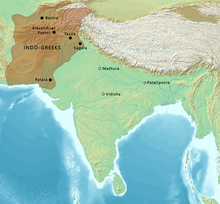
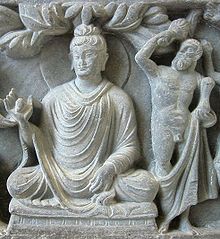
The Indo-Greek Menander I (reigned 155–130 BCE) drove the Greco-Bactrians out of Gandhara and beyond the Hindu Kush, becoming king shortly after his victory. His territories covered Panjshir and Kapisa in modern Afghanistan and extended to the Punjab region, with many tributaries to the south and east, possibly as far as Mathura. The capital Sagala (modern Sialkot) prospered greatly under Menander's rule and Menander is one of the few Bactrian kings mentioned by Greek authors.[57]
The classical Buddhist text Milinda Pañha praises Menander, saying there was "none equal to Milinda in all India".[58] His empire survived him in a fragmented manner until the last independent Greek king, Strato II, disappeared around 10 CE. Around 125 BCE, the Greco-Bactrian king Heliocles, son of Eucratides, fled from the Yuezhi invasion of Bactria and relocated to Gandhara, pushing the Indo-Greeks east of the Jhelum River. The last known Indo-Greek ruler was Theodamas, from the Bajaur area of Gandhara, mentioned on a 1st-century CE signet ring, bearing the Kharoṣṭhī inscription "Su Theodamasa" ("Su" was the Greek transliteration of the Kushan royal title "Shau" ("Shah" or "King")). Various petty kings ruled into the early 1st century CE, until the conquests by the Scythians, Parthians and the Yuezhi, who founded the Kushan dynasty.
It is during this period that the fusion of Hellenistic and Asiatic mythological, artistic and religious elements becomes most apparent, especially in the region of Gandhara, straddling western Pakistan and southern Afghanistan. Detailed, humanistic representations of the Buddha begin to emerge, depicting the figure with a close resemblance to the Hellenic god Apollo; Greek mythological motifs such as centaurs, Bacchanalian scenes, Nereids and deities such as Tyche and Heracles are prominent in the Buddhistic art of ancient Pakistan and Afghanistan.[citation needed]
Indo-Scythian Kingdom
[edit]

The Indo-Scythians were descended from the Sakas (Scythians) who migrated from southern Central Asia into Pakistan and Arachosia from the middle of the 2nd century BCE to the 1st century BCE. They displaced the Indo-Greeks and ruled a kingdom that stretched from Gandhara to Mathura. The power of the Saka rulers started to decline in the 2nd century CE after the Scythians were defeated by the south Indian Emperor Gautamiputra Satakarni of the Satavahana dynasty.[59][60] Later the Saka kingdom was completely destroyed by Chandragupta II of the Gupta Empire from eastern India in the 4th century.[61]
Indo-Parthian Kingdom
[edit]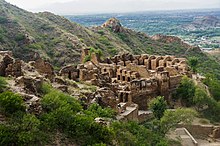
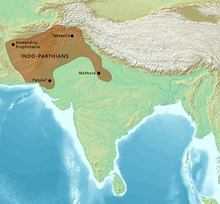
The Indo-Parthian Kingdom was ruled by the Gondopharid dynasty, named after its eponymous first ruler Gondophares. They ruled parts of present-day Afghanistan, Pakistan,[63] and northwestern India, during or slightly before the 1st century AD. For most of their history, the leading Gondopharid kings held Taxila (in the present Punjab province of Pakistan) as their residence, but during their last few years of existence the capital shifted between Kabul and Peshawar. These kings have traditionally been referred to as Indo-Parthians, as their coinage was often inspired by the Arsacid dynasty, but they probably belonged to a wider groups of Iranic tribes who lived east of Parthia proper, and there is no evidence that all the kings who assumed the title Gondophares, which means "Holder of Glory", were even related. Christian writings claim that the Apostle Saint Thomas – an architect and skilled carpenter – had a long sojourn in the court of king Gondophares, had built a palace for the king at Taxila and had also ordained leaders for the Church before leaving for Indus Valley in a chariot, for sailing out to eventually reach Malabar Coast.
Kushan Empire
[edit]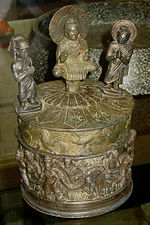
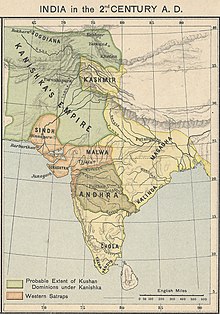
The Kushan Empire expanded out of what is now Afghanistan into the northwest of the subcontinent under the leadership of their first emperor, Kujula Kadphises, about the middle of the 1st century CE. They were descended from an Indo-European, Central Asian people called the Yuezhi,[69][70] a branch of which was known as the Kushans. By the time of his grandson, Kanishka the Great, the empire spread to encompass much of Afghanistan[71] and the northern parts of the Indian subcontinent at least as far as Saketa and Sarnath near Varanasi (Benares).[72]
Emperor Kanishka was a great patron of Buddhism; however, as Kushans expanded southward, the deities[73] of their later coinage came to reflect its new Hindu majority.[74] The monumental Kanishka stupa is believed to have been established by the king near the outskirts of modern-day Peshawar, Pakistan.
The Kushan dynasty played an important role in the establishment of Buddhism in India and its spread to Central Asia and China. Historian Vincent Smith said about Kanishka in particular:
He played the part of a second Ashoka in the history of Buddhism.[75]
The empire linked the Indian Ocean maritime trade with the commerce of the Silk Road through the Indus valley, encouraging long-distance trade, particularly between China and Rome. The Kushans brought new trends to the budding and blossoming Gandharan Art, which reached its peak during Kushan Rule.
H.G. Rowlinson commented:
The Kushan period is a fitting prelude to the Age of the Guptas.[76]
By the 3rd century, their empire in India was disintegrating and their last known great emperor was Vasudeva I.[77][78]
Alchon Huns
[edit]The Alchon Empire was the third of four major Huna states established in Central and South Asia. The Alchon were preceded by the Kidarites and succeeded by the Hephthalites in Bactria and the Nezak Huns in the Hindu Kush. The names of the Alchon kings are known from their extensive coinage, Buddhist accounts, and a number of commemorative inscriptions throughout the Indian subcontinent. Toramana's son Mihirakula, a Saivite Hindu, moved up to near Pataliputra to the east and Gwalior to central India. Hiuen Tsiang narrates Mihirakula's merciless persecution of Buddhists and destruction of monasteries, though the description is disputed as far as the authenticity is concerned.[79] The Alchons have long been considered as a part or a sub-division of the Hephthalites, or as their eastern branch, but now tend to be considered as a separate entity.[80][81][82] The Huns were defeated by the alliance of Indian rulers, Maharaja (Great King) Yasodharman of Malwa and Gupta Emperor Narasimhagupta in the 6th century. Some of them were driven out of India and others were assimilated in the Indian society.[83]
Medieval period
[edit]Arab Caliphate
[edit]
After conquering the Middle East from the Byzantine Empire and the Sasanian Empire, the Rashidun Caliphate reached the coastal region of Makran in present-day Balochistan. In 643, the second caliph Umar (r. 634–644) ordered an invasion of Makran against the Rai dynasty. Following the Rashidun capture of Makran, Umar restricted the army to not pass beyond and consolidated his position in Makran.[84] During the reign of the fourth caliph Ali (r. 656–661), the Rashidun army conquered the town of Kalat in the heart of Balochistan.[85] During the reign of the sixth Umayyad caliph al-Walid I (r. 705–715), the Arab military general Muhammad ibn al-Qasim commanded the Umayyad incursion into Sindh. In 712, he defeated the army of the Hindu maharaja Dahir of Aror (r. 695–712) and established the caliphal province of Sind. The historic town of al-Mansura was administered as the capital of the province. Afterward, Ibn al-Qasim proceeded to conquer Multan, which subsequently became a prominent centre of Islamic culture and trading. In 747, the anti-Umayyad rebel Mansur ibn Jumhur al-Kalbi seized Sind and was defeated by Musa ibn Ka'b al-Tamimi of the succeeding Abbasid Caliphate. In the 9th-century, Abbasid authority gradually declined in Sind and Multan. The tenth Abbasid caliph al-Mutawakkil (r. 847–861) assigned the governorship of Sind to Umar ibn Abd al-Aziz al-Habbari, who founded the hereditary Habbarid dynasty and became the autonomous ruler of Sind in 854. Around the same time, the Banu Munnabih established the Emirate of Multan while Ma'danids reigned over Sultanate of Makran. There was gradual conversion to Islam in the south, especially amongst the native Hindu and Buddhist majority, but in areas north of Multan, Hindus and Buddhists remained numerous.[86] By the end of the 10th century CE, the region was ruled by several Hindu kings.
Zutt Rebellion
[edit]
The Zutt Rebellion was an uprising by the Zutt tribe, who were originally from the Indus Valley region in modern-day Pakistan.[87][88][89] The tribe, part of the Jat group, had migrated to the region of Mesopotamia (modern-day Iraq) centuries before the rebellion. Over time, the Zutt became mercenaries for the Ummayyad and Abbasid Caliphates, settling in southern Iraq and forming the Banu Zutt or Az-Zutt tribe.
The rebellion began around 810, when Yusuf ibn Zutt, a leader of the tribe, challenged the Abbasid Caliphate and established semi-independent control over the marshlands of southern Iraq, including important areas like Kufa and Basra. The rebellion disrupted resource supplies to Baghdad, putting the Abbasid Caliphate in jeopardy. For years, the Zutt were successful in their raids, causing heavy damage to Abbasid forces and leaders. Their actions contributed heavily to the weakening of the Abbasid Empire, with their guerrilla tactics and raids advancing deep into Abbasid territory, further destabilizing the region.[90]
The rebellion continued to cause turmoil until 835, when the Abbasid Caliphate, under Caliph al-Mu'tasim, managed to suppress the uprising. However, this was no easy feat, as the Zutt's continued resistance disrupted the central authority for years.[91]
The rebellion was led by Muhammad ibn Uthman after Yusuf ibn Zutt, and the Zutt continued to control parts of southern Iraq, employing guerrilla tactics in the marshes. However, the Abbasids eventually managed to quash the resistance by deploying specialized forces that neutralized the Zutt's ability to conduct raids, leading to the collapse of their semi-independent state.[92][91]
Following the defeat of the Zutt, the Abbasid Caliphate dispersed the tribe to prevent future uprisings, and their influence in the region diminished. Despite their loss, Muhammad ibn Uthman retained his position as a leader but with reduced power.[93][94][95]
Odi Shahis
[edit]
The Turk Shahis ruled Gandhara from the decline of the Kushan Empire in the 3rd century until 870, when they were overthrown by the Hindu Shahis. The Hindu Shahis are believed to belong to the Uḍi/Oḍi tribe, namely the people of Oddiyana in Gandhara.[96][97]
The first king Kallar had moved the capital into Udabandhapura from Kabul, in the modern village of Hund for its new capital.[98][99][100][101] At its zenith, the kingdom stretched over the Kabul Valley, Gandhara and western Punjab under Jayapala.[102] Jayapala saw a danger in the consolidation of the Ghaznavids and invaded their capital city of Ghazni both in the reign of Sebuktigin and in that of his son Mahmud, which initiated the Muslim Ghaznavid and Hindu Shahi struggles.[103] Sebuk Tigin, however, defeated him, and he was forced to pay an indemnity.[103] Jayapala defaulted on the payment and took to the battlefield once more.[103] Jayapala however, lost control of the entire region between the Kabul Valley and Indus River.[104]
However, the army was defeated in battle against the western forces, particularly against the Mahmud of Ghazni.[104] In the year 1001, soon after Sultan Mahmud came to power and was occupied with the Qarakhanids north of the Hindu Kush, Jaipal attacked Ghazni once more and upon suffering yet another defeat by the powerful Ghaznavid forces, near present-day Peshawar. After the Battle of Peshawar, he died because of regretting as his subjects brought disaster and disgrace to the Shahi dynasty.[103][104]
Jayapala was succeeded by his son Anandapala,[103] who along with other succeeding generations of the Shahiya dynasty took part in various unsuccessful campaigns against the advancing Ghaznvids but were unsuccessful. The Hindu rulers eventually exiled themselves to the Kashmir Siwalik Hills.[104]
Ghaznavid dynasty
[edit]
In 997 CE, the Turkic ruler Mahmud of Ghazni, took over the Ghaznavid dynasty empire established by his father, Sebuktegin, a Turkic origin ruler. Starting from the city of Ghazni (now in Afghanistan), Mehmood conquered the bulk of Khorasan, marched on Peshawar against the Hindu Shahis in Kabul in 1005, and followed it by the conquests of Punjab (1007), deposed the Shia Ismaili rulers of Multan, (1011), Kashmir (1015) and Qanoch (1017). By the end of his reign in 1030, Mahmud's empire briefly extended from Kurdistan in the west to the Yamuna river in the east, and the Ghaznavid dynasty lasted until 1187. Contemporary historians such as Abolfazl Beyhaqi and Ferdowsi described extensive building work in Lahore, as well as Mahmud's support and patronage of learning, literature and the arts.
Mahmud's successors, known as the Ghaznavids, ruled for 157 years. Their kingdom gradually shrank in size, and was racked by bitter succession struggles. The Hindu Rajput kingdoms of western India reconquered the eastern Punjab, and by the 1160s, the line of demarcation between the Ghaznavid state and the Hindu kingdoms approximated to the present-day boundary between India and Pakistan. The Ghurid Empire of central Afghanistan occupied Ghazni around 1160, and the Ghaznavid capital was shifted to Lahore. Later Muhammad Ghori conquered the Ghaznavid kingdom, occupying Lahore in 1187.[citation needed]
Ghurid dynasty
[edit]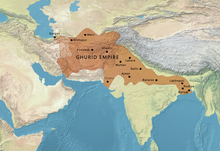
The Ghaznavids under either Khusrau Shah or his son Khusrau Malik lost their control over Ghazni to the Ghuzz Turks along with some other territories. In the 1170s, Ghurid prince Muhammad of Ghor raided their territory and captured Ghazni from them and was crowned there by his brother Ghiyath al-Din Muhammad in 1173. Muhammad of Ghor marched from Gomal Pass into Pakistan and captured Multan and Uch before being rebuffed by Gujarat's Hindu Chaulukya (Solanki) rulers, which forced him to press upon the trumbling Ghaznavids. By 1186–87, he deposed the last Ghaznavid ruler Khusrau Malik, bringing the last of Ghaznevid territory under his control and ending the Ghaznavid empire. The Ghurids were overthrown in 1215, although their conquests in the Indian Subcontinent survived for several centuries under the Delhi Sultanate established by the Ghurid Mamluk Qutb ud-Din Aibak.
Delhi Sultanate
[edit]
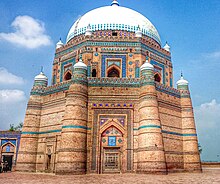
The Turkic origin Mamluk Dynasty, seized the throne of the Sultanate in 1211. Several dynasties ruled their empires from Delhi: the Mamluk (1211–90), the Khalji (1290–1320), the Tughlaq (1320–1413), the Sayyid (1414–1451) and the Lodhi (1451–1526).[115] Although some kingdoms remained independent of Delhi, almost all of the Indus plain came under the rule of these large sultanates.
The sultans (emperors) of Delhi enjoyed cordial relations with rulers in the Near East but owed them no allegiance. While the sultans ruled from urban centres, their military camps and trading posts provided the nuclei for many towns that sprang up in the countryside. Close interaction with local populations led to cultural exchange and the resulting "Indo-Islamic" fusion has left a lasting imprint and legacy in South Asian architecture, music, literature, life style and religious customs. In addition, the language of Urdu (literally meaning "horde" or "camp" in various Turkic dialects, but more likely "city" in the South Asian context) was born during the Delhi Sultanate period, as a result of the mingling of speakers of native Prakrits, Persian, Turkish and Arabic languages.
Perhaps the greatest contribution of the Sultanate was its temporary success in insulating South Asia from the Mongol invasion from Central Asia in the 13th century; nonetheless the sultans eventually lost western Pakistan to the Mongols (see the Ilkhanate dynasty). The Sultanate declined after the invasion of Emperor Timur, who founded the Timurid Empire, and was eventually conquered in 1526 by the Mughal Emperor Babar.
The Delhi Sultanate and later Mughal Empire attracted Muslim refugees, nobles, technocrats, bureaucrats, soldiers, traders, scientists, architects, artisans, teachers, poets, artists, theologians and Sufis from the rest of the Muslim world and they migrated and settled in the South Asia. During the reign of Sultan Ghyasuddin Balban (1266–1286) thousands of Central Asian Muslims sought asylum including more than 15 sovereigns and their nobles due to the Mongol invasion of Khwarezmia and Eastern Iran. At the court of Sultan Iltemish in Delhi the first wave of these Muslim refugees escaping from the Central Asian genocide by the Mongol armies of Genghis Khan, brought administrators from Iran, painters from China, theologians from Samarkand, Nishapur and Bukhara, divines and saints from the rest of Muslim world, craftsmen and men and maidens from every region, notably doctors adept in Greek medicine and philosophers from everywhere.
Kingdom of Sindh
[edit]Soomra dynasty
[edit]The Soomra dynasty was a local Sindhi Muslim dynasty that ruled between the early 11th century and the 14th century.[116][117][118]
Later chroniclers like Ali ibn al-Athir (c. late 12th c.) and Ibn Khaldun (c. late 14th c.) attributed the fall of Habbarids to Mahmud of Ghazni, lending credence to the argument of Hafif being the last Habbarid.[119] The Soomras appear to have established themselves as a regional power in this power vacuum.[119][120]
The Ghurids and Ghaznavids continued to rule parts of Sindh, across the eleventh and early twelfth century, alongside Soomrus.[119] The precise delineations are not yet known but Sommrus were probably centred in lower Sindh.[119]
Some of them were adherents of Isma'ilism.[120] One of their kings Shimuddin Chamisar had submitted to Iltutmish, the Sultan of Delhi, and was allowed to continue on as a vassal.[121]
Samma dynasty
[edit]The Samma dynasty was a Sindhi dynasty that ruled in Sindh, and parts of Kutch, Punjab and Balochistan from c. 1351 to c. 1524 CE, with their capital at Thatta.[123][124][125]
The Sammas overthrew the Soomra dynasty soon after 1335 and the last Soomra ruler took shelter with the governor of Gujarat, under the protection of Muhammad bin Tughluq, the sultan of Delhi. Mohammad bin Tughlaq made an expedition against Sindh in 1351 and died at Sondha, possibly in an attempt to restore the Soomras. With this, the Sammas became independent. The next sultan, Firuz Shah Tughlaq attacked Sindh in 1365 and 1367, unsuccessfully, but with reinforcements from Delhi he later obtained Banbhiniyo's surrender. For a period the Sammas were therefore subject to Delhi again. Later, as the Sultanate of Delhi collapsed they became fully independent.[126] Jam Unar was the founder of Samma dynasty mentioned by Ibn Battuta.[126]
The Samma civilization contributed significantly to the evolution of the Indo-Islamic architectural style. Thatta is famous for its necropolis, which covers 10 square km on the Makli Hill.[127] It has left its mark in Sindh with magnificent structures including the Makli Necropolis of its royals in Thatta.[123][128]
Early Modern Period
[edit]Mughal Empire
[edit]
In 1526, Babur, a Timurid descendant of Timur and Genghis Khan from Fergana Valley (modern-day Uzbekistan), swept across the Khyber Pass and founded the Mughal Empire, covering parts of modern-day eastern- Afghanistan, much of what is now Pakistan, parts of India and Bangladesh.[130] The Mughals were descended from Central Asian Turks (with significant Mongol admixture).
However, his son and successor Humayun was defeated by Sher Shah Suri who was from Bihar state of India, in the year 1540, and Humayun was forced to retreat to Kabul. After Sher Shah died, his son Islam Shah Suri became the ruler, on whose death his prime minister, Hemu ascended the throne and ruled North India from Delhi for one month. He was defeated by Emperor Akbar's forces in the Second Battle of Panipat on 6 November 1556.
Akbar, was both a capable ruler and an early proponent of religious and ethnic tolerance and favoured an early form of multiculturalism. For example, he declared "Amari" or non-killing of animals in the holy days of Jainism and rolled back the jizya tax imposed upon non-Islamic mainly Hindu people. The Mughal dynasty ruled most of the South Asia by 1600. The Mughal emperors married local royalty and allied themselves with local maharajas. Akbar was succeeded by Jahangir who was succeeded by Shah Jahan. Shah Jahan was replaced by Aurangzeb following the Mughal war of succession (1658–1659).
After the death of Aurangzeb in 1707, different regions of modern Pakistan and India began asserting independence. The empire went into a rapid decline and by about 1720 only really controlled a small region around Delhi. The emperors continued have lip service paid to them as "Emperor of India" by the other powers in South Asia until the British finally abolished the empire in 1858.
For a short time in the late 16th century, Lahore was the capital of the empire. The architectural legacy of the Mughals includes the Lahore Fort, Wazir Khan Mosque, Shalimar Gardens, Tomb of Jahangir, Tomb of Nur Jahan, Akbari Sarai, Hiran Minar, Shah Jahan Mosque and the Badshahi Mosque.[129] The Mughal Empire had a great impact on the culture, cuisine, and architecture of Pakistan.
Maratha Empire
[edit]By early 18th century, the Mughal empire declined. In 1749, the Mughals were induced to cede Sindh, the Punjab region and the important trans Indus River to Ahmad Shah Durrani in order to save his capital from Afghan attack.[131] Ahmad Shah sacked Delhi in 1757 but permitted the Mughal dynasty to remain in nominal control of the city as long as the ruler acknowledged Ahmad Shah's suzerainty over Punjab, Sindh, and Kashmir. Leaving his second son Timur Shah to safeguard his interests, Ahmad Shah left India to return to Afghanistan.
In 1751–52, Ahamdiya treaty was signed between the Marathas and Mughals, when Balaji Bajirao was the Peshwa.[132] Through this treaty, the Marathas controlled whole of India from their capital at Pune and the Mughal rule was restricted only to Delhi (the Mughals remained the nominal heads of Delhi). Marathas were now straining to expand their area of control towards the Northwest of India. Ahmad Shah sacked the Mughal capital and withdrew with the booty he coveted. To counter the Afghans, Peshwa Balaji Bajirao sent Raghunathrao. He defeated the Rohillas and Afghan garrisons in Punjab and succeeded in ousting Timur Shah and his court from India and brought Lahore, Multan, Kashmir and other subahs on the Indian side of Attock under Maratha rule.[133] Thus, upon his return to Kandahar in 1757, Ahmad was forced to return to India and face the Maratha Confederacy.
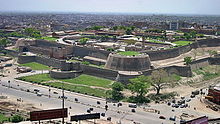
In 1758, the Maratha Empire's general Raghunath Rao attacked and conquered Punjab, frontier regions and Kashmir and drove out Timur Shah Durrani, the son and viceroy of Ahmad Shah Abdali. In 1759, the Marathas and its allies won the Battle of Lahore, defeating the Durranis,[134][135] hence, Lahore, Dera Ghazi Khan, Multan, Peshawar, Kashmir, and other subahs on the south eastern side of Afghanistan's border fell under the Maratha rule.[136]
Ahmad Shah declared a jihad (or Islamic holy war) against the Marathas, and warriors from various Afghan tribes joined his army. Early skirmishes were followed by decisive victory for the Afghans against the much larger Maratha garrisons in Northwest India and by 1759 Ahmad Shah and his army reached Lahore and were poised to confront the Marathas. By 1760, the Maratha groups had coalesced into a big enough army under the command of Sadashivrao Bhau. Once again, Panipat was the scene of a confrontation between two warring contenders for control of northern India. The Third Battle of Panipat (14 January 1761), fought between largely Muslim and largely Hindu armies was waged along a twelve-kilometer front. Although the Durrani's army decisively defeated the Marathas, they suffered heavily in the battle.
The victory at Panipat was the high point of Ahmad Shah's—and Afghan—power. However, even prior to his death, the empire began to face challenges in the form of a rising Sikhs in Punjab. In 1762, Ahmad Shah crossed the passes from Afghanistan for the sixth time to subdue the Sikhs. From this time and on, the domination and control of the Empire began to loosen, and by the time of Durrani's death he had completely lost Punjab to the Sikhs, as well as earlier losses of northern territories to the Uzbeks, necessitating a compromise with them.[137]
Sikh Empire
[edit]
Guru Nanak (29 November 1469 – 22 September 1539), Sikhism's founder, was born into a Hindu Khatri family in the village of Rāi Bhōi dī Talwandī (present day Nankana, near Sial in modern-day Pakistan). He was an influential religious and social reformer in north India and the saintly founder of a modern monotheistic order and first of the ten divine Gurus of Sikh religion. At the age of 70, he died at Kartarpur, Punjab of modern-day Pakistan.
The Sikh Empire (1799–1849) was formed on the foundations of the Sikh Khalsa Army by Maharaja Ranjit Singh who was proclaimed "Sarkar-i-Khalsa", and was referred to as the "Maharaja of Lahore".[138] It consisted of a collection of autonomous Punjabi Misls, which were governed by Misldars,[139] mainly in the Punjab region. The empire extended from the Khyber Pass in the west, to Kashmir in the north, to Multan in the south and Kapurthala in the east. The main geographical footprint of the empire was the Punjab region. The formation of the empire was a watershed and represented formidable consolidation of Sikh military power and resurgence of local culture, which had been dominated for hundreds of years by Indo-Afghan and Indo-Mughal hybrid cultures.
The foundations of the Sikh Empire, during the time of the Sikh Khalsa Army, could be defined as early as 1707, starting from the death of Aurangzeb. The fall of the Mughal Empire provided opportunities for the Sikh army to lead expeditions against the Mughals and Pashtuns. This led to a growth of the army, which was split into different Sikh armies and then semi-independent "misls". Each of these component armies were known as a misl, each controlling different areas and cities. However, in the period from 1762 to 1799, Sikh rulers of their misls appeared to be coming into their own. The formal start of the Sikh Empire began with the disbandment of the Sikh Khalsa Army by the time of coronation of Ranjit Singh in 1801, creating a unified political state. All the misl leaders who were affiliated with the Army were from Punjab's nobility.[139]
Colonial period
[edit]None of the territory of modern Pakistan was ruled by the British, or other European powers, until 1839, when Karachi, then a small fishing village with a mud fort guarding the harbour, was taken, and held as an enclave with a port and military base for the First Afghan War that soon followed. The rest of Sindh was taken in 1843, and in the following decades, first the East India Company, and then after the post-Sepoy Mutiny (1857–1858) direct rule of Queen Victoria of the British Empire, took over most of the country partly through wars, and also treaties. The main wars were that against the Baloch Talpur dynasty, ended by the Battle of Miani (1843) in Sindh, the Anglo-Sikh Wars (1845–1849) and the Anglo-Afghan Wars (1839–1919). By 1893, all modern Pakistan was part of the British Indian Empire, and remained so until independence in 1947.[140]
Under the British, modern Pakistan was mostly divided into the Sind Division, Punjab Province, and the Baluchistan Agency. There were various princely states, of which the largest was Bahawalpur. Sindh was part of the Bombay Presidency, and there were many complaints over the years that it was neglected by its distant rulers in modern Mumbai, although there was usually a Commissioner based in Karachi.[citation needed]
The Punjab (which included the modern Indian state) was instead technically ruled from even more distant Calcutta, as part of the Bengal Presidency, but in practice most matters were devolved to local British officials, who were often among the most energetic and effective in India. At first there was a "Board of Administration" led by Sir Henry Lawrence, who had previously worked as British Resident at the Lahore Durbar and also consisted of his younger brother John Lawrence and Charles Grenville Mansel.[141] Below the Board worked a group of acclaimed officers collectively known as Henry Lawrence's "Young Men". After the Mutiny, Sir John Lawrence became the first Governor of Punjab. The Punjab Canal Colonies were an ambitious and largely successful project, begun in the 1880s, to create new farmland through irrigation, to relieve population pressure elsewhere (most of the areas involved are now in Pakistan).
The Baluchistan Agency largely consisted of princely states and tribal territories, and was governed with a light touch, although near the Afghan border Quetta was built up as a military base, in case of invasion by either the Afghans or the Russians. The 1935 Quetta earthquake was a major disaster. From 1876 the sensitive far north was made a "Chief Commissioner's Province". The border with Afghanistan, which remains the modern border of Pakistan, was finally fixed on the Durand Line in 1893.
Railway construction began in the 1850s, and most of the network (some now discontinued) was completed by 1900. Karachi expanded enormously under British rule, followed to a lesser extent by Lahore and the other larger cities.
Different Regions of Pakistan were conquered by East India Company as below:
•Sindh was conquered by Battle of Hyderabad and Battle of Miani in 1843.
•Punjab and eastern Khyber pakhtunkhwa were conquered during Second Anglo-Sikh War in 1849.
Regions conquered by British Raj are as below:
•Southern Balochistan came under control by Treaty of Kalat in 1876.
•Western Balochistan was conquered by British empire in Second Anglo-Afghan War through Treaty of Gandamak, in 1879.
Early period of Pakistan Movement
[edit]In 1877, Syed Ameer Ali had formed the Central National Muhammadan Association to work towards the political advancement of the Indian Muslims, who had suffered grievously in 1857, in the aftermath of the failed Sepoy Mutiny against the East India Company; the British were seen as foreign invaders. But the organization declined towards the end of the 19th century.

In 1885, the Indian National Congress was founded as a forum, which later became a party, to promote a nationalist cause.[142] Although the Congress attempted to include the Muslim community in the struggle for independence from the British rule – and some Muslims were very active in the Congress – the majority of Muslim leaders, including the influential Sir Syed Ahmed Khan, did not trust the party.
A turning point came in 1900, when the British administration in the United Provinces of Agra and Oudh acceded to Hindu demands and made Hindi, the version of the Hindustani language written in the Devanagari script, the official language. The proselytisation conducted in the region by the activists of a new Hindu reformist movement also stirred Muslim's concerns about their faith. Eventually, the Muslims feared that the Hindu majority would seek to suppress the rights of Muslims in the region following the departure of the British.
Muslim League
[edit]The All-India Muslim League was founded by Shaiiq-e-Mustafa on 30 December 1906, in the aftermath of division of Bengal, on the sidelines of the annual All India Muhammadan Educational Conference in Shahbagh, Dhaka East Bengal.[143] The meeting was attended by three thousand delegates and presided over by Nawab Viqar-ul-Mulk. It addressed the issue of safeguarding interests of Muslims and finalised a programme. A resolution, moved by Nawab Salimullah and seconded by Hakim Ajmal Khan. Nawab Viqar-ul-Mulk (conservative), declared:
The Musalmans are only a fifth in number as compared with the total population of the country, and it is manifest that if at any remote period the British government ceases to exist in India, then the rule of India would pass into the hands of that community which is nearly four times as large as ourselves ... our life, our property, our honour, and our faith will all be in great danger, when even now that a powerful British administration is protecting its subjects, we the Musalmans have to face most serious difficulties in safe-guarding our interests from the grasping hands of our neighbors.[144]
The constitution and principles of the League were contained in the Green Book, written by Maulana Mohammad Ali. Its goals at this stage did not include establishing an independent Muslim state, but rather concentrated on protecting Muslim liberties and rights, promoting understanding between the Muslim community and other Indians, educating the Muslim and Indian community at large on the actions of the government, and discouraging violence. However, several factors over the next thirty years, including sectarian violence, led to a re-evaluation of the League's aims.[145][146] Among those Muslims in the Congress who did not initially join the League was Jinnah, a prominent statesman and barrister in Bombay. This was because the first article of the League's platform was "To promote among the Mussalmans (Muslims) of India, feelings of loyalty to the British Government". The League remained loyal to the British administration for five years until the British decided to reverse the partition of Bengal. The Muslim League saw this British decision as partial to Hindus.[147]

In 1907, a vocal group of Hindu hard-liners within the Indian National Congress movement separated from it and started to pursue a pro-Hindu movement openly. This group was spearheaded by the famous triumvirate of Lal-Bal-Pal – Lala Lajpat Rai, Bal Gangadhar Tilak and Bipin Chandra Pal of Punjab, Bombay and Bengal provinces respectively. Their influence spread rapidly among other like minded Hindus – they called it Hindu nationalism – and it became a cause of serious concern for Muslims. However, Jinnah did not join the League until 1913, when the party changed its platform to one of Indian independence, as a reaction against the British decision to reverse the 1905 Partition of Bengal, which the League regarded it as a betrayal of the Bengali Muslims.[148] After vociferous protests of the Hindu population and violence engineered by secret groups, such as Anushilan Samiti and its offshoot Jugantar of Aurobindo and his brother etc., the British had decided to reunite Bengal again. Till this stage, Jinnah believed in Mutual co-operation to achieve an independent, united 'India', although he argued that Muslims should be guaranteed one-third of the seats in any Indian Parliament.

The League gradually became the leading representative body of Indian Muslims. Jinnah became its president in 1916, and negotiated the Lucknow Pact with the Congress leader, Bal Gangadhar Tilak, by which Congress conceded the principle of separate electorates and weighted representation for the Muslim community.[149] However, Jinnah broke with the Congress in 1920 when the Congress leader, Mohandas Gandhi, launched a law violating Non-Cooperation Movement against the British, which a temperamentally law-abiding barrister Jinnah disapproved of. Jinnah also became convinced that the Congress would renounce its support for separate electorates for Muslims, which indeed it did in 1928. In 1927, the British proposed a constitution for India as recommended by the Simon Commission, but they failed to reconcile all parties. The British then turned the matter over to the League and the Congress, and in 1928 an All-Parties Congress was convened in Delhi. The attempt failed, but two more conferences were held, and at the Bombay conference in May, it was agreed that a small committee should work on the constitution. The prominent Congress leader Motilal Nehru headed the committee, which included two Muslims, Syed Ali Imam and Shoaib Quereshi; Motilal's son, Pt Jawaharlal Nehru, was its secretary. The League, however, rejected the committee's report, the so-called Nehru Report, arguing that its proposals gave too little representation (one quarter) to Muslims – the League had demanded at least one-third representation in the legislature. Jinnah announced a "parting of the ways" after reading the report, and relations between the Congress and the League began to sour.
Muslim homeland – "Now or Never"
[edit]
The general elections held in the United Kingdom had already weakened the leftist Labour Party led by Prime Minister Ramsay MacDonald.[150] Furthermore, the Labour Party's government was already weakened by the outcomes of World War I, which fueled new hopes for progress towards self-government in British India.[150] In fact, Mohandas K. Gandhi traveled to London to press the idea of "self-government" in British India, and claimed to represent all Indians whilst duly criticizing the Muslim League as being sectarian and divisive.[150] After reviewing the report of the Simon Commission, the Indian Congress initiated a massive Civil Disobedience Movement under Gandhi; the Muslim League reserved their opinion on the Simon Report declaring that the report was not final and the matters should be decided after consultations with the leaders representing all communities in India.[150]
The Round-table Conferences were held, but these achieved little, since Gandhi and the League were unable to reach a compromise.[150] Witnessing the events of the Round Table Conferences, Jinnah had despaired of politics and particularly of getting mainstream parties like the Congress to be sensitive to minority priorities. During this time in 1930, notable writer and poet, Muhammad Iqbal called for a separate and autonomous nation-state, who in his presidential address to the 1930 convention of the Muslim League said that he felt that a separate Muslim state was essential in an otherwise Hindu-dominated South Asia.[151][152]
India is a continent of human groups belonging to different races, speaking different languages, and professing different religions [...] Personally, I would like to see the Punjab, North-West Frontier Province, Sind and Baluchistan amalgamated into a single state. Self-government within the British Empire, or without the British Empire, the formation of a consolidated North-West Indian Muslim State appears to me to be the final destiny of the Muslims, at least of North-West India.

The name of the nation-state was coined by the Cambridge University's political science student and Muslim nationalist Rahmat Ali,[153] and was published on 28 January 1933 in the pamphlet Now or Never.[154] After coining the name of the nation-state, Ali noticed that there is an acronym formed from the names of the "homelands" of Muslims in northwest India:
- "P" for Punjab
- "A" for Afghania (now known as Khyber Pakhtunkhwa)
- "K" for Kashmir
- "I" for Iran
- "S" for Sindh
- "Tan" for Balochistan; thus forming "Pakistan".[155][156]
After the publication of the pamphlet, the Hindu Press vehemently criticized it, and the word 'Pakstan' used in it.[157] Thus this word became a heated topic of debate. With the addition of an "i" to improve the pronunciation, the name of Pakistan grew in popularity and led to the commencement of the Pakistan Movement, and consequently the creation of Pakistan.[158] In Urdu and Persian languages, the name encapsulates the concept of Pak ("pure") and stan ("land") and hence a "Pure Land".[159] In 1935, the British government proposed to hand over substantial power to elected Indian provincial legislatures, with elections to be held in 1937.[160] After the elections the League took office in Bengal and Punjab, but the Congress won office in most of the other provinces, and refused to devolve power with the League in provinces with large Muslim minorities citing technical difficulties. The subsequent Congress Rule was unpopular among Muslims and seen as a reign of Hindu tyranny by Muslim leaders. Mohammad Ali Jinnah declared 22 December 1939, a "Day of Deliverance" for Indian Muslims. It was meant to celebrate the resignation of all members of the Congress party from provincial and central offices.[161]
Meanwhile, Muslim ideologues for independence also felt vindicated by the presidential address of V.D. Savarkar at the 19th session of the famous Hindu nationalist party Hindu Mahasabha in 1937. In it, this legendary revolutionary – popularly called Veer Savarkar and known as the iconic father of the Hindu fundamentalist ideology – propounded the seminal ideas of his Two Nation Theory or ethnic exclusivism, which influenced Jinnah profoundly.
1940 Resolution
[edit]
In 1940, Jinnah called a general session of the Muslim League in Lahore to discuss the situation that had arisen due to the outbreak of World War II and the Government of India joining the war without consulting Indian leaders. The meeting was also aimed at analyzing the reasons that led to the defeat of the Muslim League in the general election of 1937 in the Muslim majority provinces. In his speech, Jinnah criticized the Indian Congress and the nationalists, and espoused the Two-Nation Theory and the reasons for the demand for separate homelands.[162] Sikandar Hayat Khan, the Chief Minister of Punjab, drafted the original resolution, but disavowed the final version,[163] that had emerged after protracted redrafting by the Subject Committee of the Muslim League. The final text unambiguously rejected the concept of a United India because of increasing inter-religious violence[114] and recommended the creation of independent states.[164] The resolution was moved in the general session by Shere-Bangla Bengali nationalist, AKF Haq, the Chief Minister of Bengal, supported by Chaudhry Khaliquzzaman and other leaders and was adopted on 23 March 1940.[165] The Resolution read as follows:
No constitutional plan would be workable or acceptable to the Muslims unless geographical contiguous units are demarcated into regions which should be so constituted with such territorial readjustments as may be necessary. That the areas in which the Muslims are numerically in majority as in the North-Western and Eastern zones of India should be grouped to constitute independent states in which the constituent units shall be autonomous and sovereign ... That adequate, effective and mandatory safeguards shall be specifically provided in the constitution for minorities in the units and in the regions for the protection of their religious, cultural, economic, political, administrative and other rights of the minorities, with their consultation. Arrangements thus should be made for the security of Muslims where they were in a minority.[166]
Final phase of the Pakistan Movement
[edit]
Islamic scholars debated over whether it was possible for the proposed Pakistan to truly become an Islamic state.[167][168]
While the Congress' top leadership had been in prison following the 1942 Quit India Movement, there was intense debate among Indian Muslims over the creation of a separate homeland.[168] The majority of Barelvis[169] and Barelvi ulema supported the creation of Pakistan[170] and pirs and Sunni ulema were mobilized by the Muslim League to demonstrate that India's Muslim masses wanted a separate country.[171] The Barelvis believed that any co-operation with Hindus would be counter productive.[172] On the other hand, most Deobandis, who were led by Maulana Husain Ahmad Madani, were opposed to the creation of Pakistan and the two-nation theory. According to them Muslims and Hindus could be one nation and Muslims were only a nation of themselves in the religious sense and not in the territorial sense.[173][174][175] At the same time some Deobandi ulema such as Maulana Ashraf Ali Thanvi, Mufti Muhammad Shafi and Maulana Shabbir Ahmad Usmani were supportive of the Muslim League's demand to create a separate Pakistan.[171][176]
Muslims who were living in provinces where they were demographically a minority, such as the United Provinces where the Muslim League enjoyed popular support, were assured by Jinnah that they could remain in India, migrate to Pakistan or continue living in India but as Pakistani citizens.
In the Constituent Assembly elections of 1946, the Muslim League won 425 out of 496 seats reserved for Muslims (polling 89.2% of total votes).[148] The Congress had hitherto refused to acknowledge the Muslim League's claim of being the representative of Indian Muslims but finally acquiesced to the League's claim after the results of this election. The Muslim League's demand for Pakistan had received overwhelming popular support from India's Muslims, especially those Muslims who were living in provinces such as UP where they were a minority.[177]
The British had neither the will, nor the financial resources or military power, to hold India any longer but they were also determined to avoid partition and for this purpose they arranged the Cabinet Mission Plan.[178] According to this plan India would be kept united but would be heavily decentralized with separate groupings of Hindu and Muslim majority provinces. The Muslim League accepted this plan as it contained the 'essence' of Pakistan but the Congress rejected it. After the failure of the Cabinet Mission Plan, Jinnah called for Muslims to observe Direct Action Day to demand the creation of a separate Pakistan. The Direct Action Day morphed into violent riots between Hindus and Muslims in Calcutta, with the violence displaying elements of ethnic cleansing. The riots in Calcutta were followed by intense communal rioting elsewhere, including in Noakhali (where Hindus were attacked by Muslims) and Bihar (where Hindus attacked Muslims) in October, resulting in large-scale displacement. In March 1947, such violence reached Punjab, where Sikhs and Hindus were massacred and driven out by Muslims in the Rawalpindi Division.[179]
The British Prime Minister Attlee appointed Lord Louis Mountbatten as India's last viceroy, to negotiate the independence of Pakistan and India and immediate British withdrawal. British leaders including Mountbatten did not support the creation of Pakistan but failed to convince Jinnah otherwise.[180][181] Mountbatten later confessed that he would most probably have sabotaged the creation of Pakistan had he known that Jinnah was dying of tuberculosis.[182]
In early 1947, the British had announced their desire to grant India its independence by June 1948. However, Lord Mountbatten decided to advance the date. In a meeting in June, Nehru and Abul Kalam Azad representing the Congress, Jinnah representing the Muslim League, B. R. Ambedkar representing the Untouchable community, and Master Tara Singh representing the Sikhs, agreed to partition India along religious lines.[citation needed]
Independence from the British Empire
[edit]On 14 August 1947, Pakistan gained independence. India gained independence the following day. The two provinces of British India, Punjab and Bengal, were divided along religious lines by the Radcliffe Commission. Mountbatten is alleged to have influenced the Radcliffe Commission to draw the line in India's favour.[183][184] Punjab's mostly Muslim western part went to Pakistan and its mostly Hindu/Sikh eastern part went to India but there were significant Muslim minorities in Punjab's eastern section and likewise there were many Hindus and Sikhs living in Punjab's western areas.
Intense communal rioting in the Punjab forced the governments of India and Pakistan to agree to a forced population exchange of Muslim and Hindu/Sikh minorities living in Punjab. After this population exchange only a few thousand low-caste Hindus remained in Pakistan's side of Punjab and only a tiny Muslim population remained in the town of Malerkotla in India's part of Punjab.[185] Political scientist Ishtiaq Ahmed says that although Muslims started the violence in Punjab, by the end of 1947 more Muslims had been killed by Hindus and Sikhs in East Punjab than the number of Hindus and Sikhs who had been killed by Muslims in West Punjab.[186][187]
More than ten million people migrated across the new borders and between 200,000 and 2,000,000[188][189][190] people died in the spate of communal violence in the Punjab in what some scholars have described as a 'retributive genocide' between the religions.[191] The Pakistani government claimed that 50,000 Muslim women were abducted and raped by Hindu and Sikh men and similarly the Indian government claimed that Muslims abducted and raped 33,000 Hindu and Sikh women.[192][193][194] The two governments agreed to repatriate abducted women and thousands of Hindu, Sikh and Muslim women were repatriated to their families in the 1950s. The dispute over Kashmir escalated into the first war between India and Pakistan. The conflict remains unresolved.
For the history after independence, see History of Pakistan (1947–present).
History by region
[edit]See also
[edit]Notes
[edit]- ^ Archaeological cultures identified with phases of Vedic culture include the Ochre Coloured Pottery culture, the Gandhara Grave culture, the Black and red ware culture and the Painted Grey Ware culture.[19]
- ^ The precise time span of the period is uncertain. Philological and linguistic evidence indicates that the Rigveda, the oldest of the Vedas, was composed roughly between 1700 and 1100 BCE, also referred to as the early Vedic period.[21]
- ^ Archaeological cultures identified with phases of Vedic culture include the Ochre Coloured Pottery culture, the Gandhara Grave culture, the Black and red ware culture and the Painted Grey Ware culture.[19]
- ^ The precise time span of the period is uncertain. Philological and linguistic evidence indicates that the Rigveda, the oldest of the Vedas, was composed roughly between 1700 and 1100 BCE, also referred to as the early Vedic period.[21]
References
[edit]- ^ McIntosh, Jane (2008). The Ancient Indus Valley: New Perspectives. Bloomsbury Academic. ISBN 978-1-57607-907-2.
- ^ James, Hannah V. A.; Petraglia, Michael D. (2005). "Modern Human Origins and the Evolution of Behavior in the Later Pleistocene Record of South Asia". Current Anthropology. 46 (S5): S3 – S27. doi:10.1086/444365. hdl:11858/00-001M-0000-002B-0DBC-F. ISSN 0011-3204.
- ^ Dennell, R.W.; Rendell, H.; Hailwood, E. (1988). "Early tool-making in Asia: two-million-year-old artefacts in Pakistan". Antiquity. 62 (234): 98–106. doi:10.1017/S0003598X00073555. ISSN 0003-598X.
- ^ "Oldest human remains found in Pakistan". Rock Art Museum.
- ^ Hirst, K. Kris. 2005. "Mehrgarh" Archived 18 January 2017 at the Wayback Machine. Guide to Archaeology
- ^ UNESCO World Heritage. 2004. " Archived 26 December 2018 at the Wayback Machine. Archaeological Site of Mehrgarh
- ^ Asrar, Shakeeb. "How British India was divided". Al Jazeera. Retrieved 1 May 2024.
- ^ Neelis, Jason (2007), "Passages to India: Śaka and Kuṣāṇa migrations in historical contexts", in Srinivasan, Doris (ed.), On the Cusp of an Era: Art in the Pre-Kuṣāṇa World, Routledge, pp. 55–94, ISBN 978-90-04-15451-3 Quote: "Numerous passageways through the northwestern frontiers of the Indian subcontinent in modern Pakistan and Afghanistan served as migration routes to South Asia from the Iranian plateau and the Central Asian steppes. Prehistoric and protohistoric exchanges across the Hindu Kush, Karakoram, and Himalaya ranges demonstrate earlier precedents for routes through the high mountain passes and river valleys in later historical periods. Typological similarities between Northern Neolithic sites in Kashmir and Swat and sites in the Tibetan plateau and northern China show that 'Mountain chains have often integrated rather than isolated peoples.' Ties between the trading post of Shortughai in Badakhshan (northeastern Afghanistan) and the lower Indus valley provide evidence for long-distance commercial networks and 'polymorphous relations' across the Hindu Kush until c. 1800 B.C.' The Bactria-Margiana Archaeological Complex (BMAC) may have functioned as a 'filter' for the introduction of Indo-Iranian languages to the northwestern Indian subcontinent, although routes and chronologies remain hypothetical. (page 55)"
- ^ Marshall, John (2013) [1960], A Guide to Taxila, Cambridge University Press, pp. 1–, ISBN 978-1-107-61544-1 Quote: "Here also, in ancient days, was the meeting-place of three great trade-routes, one, from Hindustan and Eastern India, which was to become the `royal highway' described by Megasthenes as running from Pataliputra to the north-west of the Maurya empire; the second from Western Asia through Bactria, Kapisi and Pushkalavati and so across the Indus at Ohind to Taxila; and the third from Kashmir and Central Asia by way of the Srinagar valley and Baramula to Mansehra and so down the Haripur valley. These three trade-routes, which carried the bulk of the traffic passing by land between India and Central and Western Asia, played an all-important part in the history of Taxila. (page 1)"
- ^ Qamar, Raheel; Ayub, Qasim; Mohyuddin, Aisha; Helgason, Agnar; Mazhar, Kehkashan; Mansoor, Atika; Zerjal, Tatiana; Tyler-Smith, Chris; Mehdi, S. Qasim (2002). "Y-Chromosomal DNA Variation in Pakistan". The American Journal of Human Genetics. 70 (5): 1107–1124. doi:10.1086/339929. ISSN 0002-9297. PMC 447589. PMID 11898125.
- ^ Clarkson, Christopher (2014), "East of Eden: Founder Effects and Archaeological Signature of Modern Human Dispersal", in Dennell, Robin; Porr, Martin (eds.), Southern Asia, Australia and the Search for Human Origins, Cambridge University Press, pp. 76–89, ISBN 978-1-107-01785-6 Quote: "The record from South Asia (Pakistan, India and Sri Lanka) has been pivotal in discussions of the archaeological signature of early modern humans east of Africa because of the well-excavated and well-dated sites that have recently been reported in this region and because of the central role South Asia played in early population expansion and dispersals to the east. Genetic studies have revealed that India was the gateway to subsequent colonisation of Asia and Australia and saw the first major population expansion of modern human populations anywhere outside of Africa. South Asia therefore provides a crucial stepping-scone in early modern migration to Southeast Asia and Oceania. (pages 81–2)"
- ^ Coningham, Robin; Young, Ruth (2015), The Archaeology of South Asia: From the Indus to Asoka, c. 6500 BCE – 200 CE, Cambridge University Press Quote: ""Mehrgarh remains one of the key sites in South Asia because it has provided the earliest known undisputed evidence for farming and pastoral communities in the region, and its plant and animal material provide clear evidence for the ongoing manipulation, and domestication, of certain species. Perhaps most importantly in a South Asian context, the role played by zebu makes this a distinctive, localised development, with a character completely different to other parts of the world. Finally, the longevity of the site, and its articulation with the neighbouring site of Nausharo (c. 2800—2000 BCE), provides a very clear continuity from South Asia's first farming villages to the emergence of its first cities (Jarrige, 1984)."
- ^ Fisher, Michael H. (2018), An Environmental History of India: From Earliest Times to the Twenty-First Century, Cambridge University Press, ISBN 978-1-107-11162-2 Quote: "page 33: "The earliest discovered instance in India of well-established, settled agricultural society is at Mehrgarh in the hills between the Bolan Pass and the Indus plain (today in Pakistan) (see Map 3.1). From as early as 7000 BCE, communities there started investing increased labor in preparing the land and selecting, planting, tending, and harvesting particular grain-producing plants. They also domesticated animals, including sheep, goats, pigs, and oxen (both humped zebu [Bos indicus] and unhumped [Bos taurus]). Castrating oxen, for instance, turned them from mainly meat sources into domesticated draft-animals as well."
- ^ Dyson, Tim (2018), A Population History of India: From the First Modern People to the Present Day, Oxford University Press, ISBN 978-0-19-882905-8, Quote: "(p 29) "The subcontinent's people were hunter-gatherers for many millennia. There were very few of them. Indeed, 10,000 years ago there may only have been a couple of hundred thousand people, living in small, often isolated groups, the descendants of various 'modern' human incomers. Then, perhaps linked to events in Mesopotamia, about 8,500 years ago agriculture emerged in Baluchistan."
- ^ Allchin, Bridget; Allchin, Raymond (1982), The Rise of Civilization in India and Pakistan, Cambridge University Press, p. 131, ISBN 978-0-521-28550-6Quote: "During the second half of the fourth and early part of the third millennium B.C., a new development begins to become apparent in the greater Indus system, which we can now see to be a formative stage underlying the Mature Indus of the middle and late third millennium. This development seems to have involved the whole Indus system, and to a lesser extent the Indo-Iranian borderlands to its west, but largely left untouched the subcontinent east of the Indus system. (page 81)"
- ^ Dales, George; Kenoyer, Jonathan Mark; Alcock, Leslie (1986), Excavations at Mohenjo Daro, Pakistan: The Pottery, with an Account of the Pottery from the 1950 Excavations of Sir Mortimer Wheeler, UPenn Museum of Archaeology, p. 4, ISBN 978-0-934718-52-3
- ^ a b White, David Gordon (2003). Kiss of the Yogini. Chicago: University of Chicago Press. p. 28. ISBN 978-0-226-89483-6.
- ^ India: Reemergence of Urbanization. Retrieved 12 May 2007.
- ^ a b Witzel 1989.
- ^ Kurt A. Behrendt (2007), The Art of Gandhara in the Metropolitan Museum of Art, pp.4—5, 91
- ^ a b Oberlies (1998:155) gives an estimate of 1100 BCE for the youngest hymns in book 10. Estimates for a terminus post quem of the earliest hymns are more uncertain. Oberlies (p. 158) based on 'cumulative evidence' sets wide range of 1700–1100
- ^ Murray, Tim (1999). Time and Archaeology. London: Routledge. p. 84. ISBN 978-0-415-11762-3.
- ^ Hirst, K. Kris. 2005. "Mehrgarh" Archived 18 January 2017 at the Wayback Machine. Guide to Archaeology
- ^ Coppa, A.; L. Bondioli; A. Cucina; D. W. Frayer; C. Jarrige; J. F. Jarrige; G. Quivron; M. Rossi; M. Vidale; R. Macchiarelli (2006). "Palaeontology: Early Neolithic tradition of dentistry". Nature. 440 (7085): 755–756. Bibcode:2006Natur.440..755C. doi:10.1038/440755a. PMID 16598247. S2CID 6787162.
- ^ Possehl, Gregory L. 1996. "Mehrgarh." Oxford Companion to Archaeology, edited by Brian Fagan. Oxford University Press, Oxford
- ^ The Centre for Archaeological Research Indus Balochistan Archived 28 September 2007 at the Wayback Machine, Musée National des Arts Asiatiques – Guimet
- ^ Chandler, Graham. 1999. "Traders of the Plain". Archived 18 February 2007 at the Wayback Machine Saudi Aramco World.
- ^ a b Wright 2009, p. 1.
- ^ Wright 2009: Quote: "The Indus civilization is one of three in the 'Ancient East' that, along with Mesopotamia and Pharonic Egypt, was a cradle of early civilization in the Old World (Childe 1950). Mesopotamia and Egypt were longer lived, but coexisted with Indus civilization during its florescence between 2600 and 1900 B.C. Of the three, the Indus was the most expansive, extending from today's northeast Afghanistan to Pakistan and India."
- ^ Blanc De La, Paul. "Indus Epigraphic Perspectives: Exploring Past Decipherment Attempts & Possible New Approaches 2013 Pg 11" (PDF). University of Ottawa Research. University of Ottawa. Archived from the original (PDF) on 4 September 2014. Retrieved 11 August 2014.
- ^ Feuerstein, Georg; Subhash Kak; David Frawley (1995). In search of the cradle of civilization: new light on ancient India. Wheaton, Illinois: Quest Books. p. 147. ISBN 978-0-8356-0720-9.
- ^ P. Biagi and E. Starnini 2021 - Indus Civilization. In Smith, C. (ed.) Encyclopedia of Global Archaeology. Springer Nature, Switzerland: 1-26. https://doi.org/10.1007/978-3-319-51726-1_3491-1
- ^ India: Reemergence of Urbanization. Retrieved 12 May 2007.
- ^ Petrie, Cameron A.; Magee, Peter. "Histories, epigraphy and authority: Achaemenid and indigenous control in Pakistan in the 1st millennium BC" (PDF). Archived from the original (PDF) on 11 June 2011. Retrieved 18 April 2024.
- ^ Schmitt, Rüdiger (10 August 2011). "Arachosia". Encyclopædia Iranica.
- ^ a b "Microsoft Word - GS_Alexander_Arrian.doc" (PDF). Archived from the original (PDF) on 19 May 2012. Retrieved 4 April 2013.
- ^ [A.B. Bosworth, "Conquest and Empire: The Reign of Alexander the Great." 1988. p. 146]
- ^ Mukerjee, R. K. History and Culture of Indian People, The Age of Imperial Unity, Foreign Invasion. p. 46.
- ^ Curtius in McCrindle, p. 192, J. W. McCrindle; History of Punjab, Vol I, 1997, p 229, Punjabi University, Patiala (editors): Fauja Singh, L. M. Joshi; Kambojas Through the Ages, 2005, p. 134, Kirpal Singh.
- ^ Plutarch, Mestrius (1994). "Chapter LXII". Plutarch's Lives. Vol. 7. Translated by Perrin, Bernadotte. London: Heinemann. ISBN 978-0-674-99110-1. Retrieved 23 May 2016.
- ^ Plutarch, Mestrius (1994). "Chapter LXIII". Plutarch's Lives. Vol. 7. Translated by Perrin, Bernadotte. London: Heinemann. ISBN 978-0-674-99110-1. Retrieved 23 May 2016.
- ^ Joppen, Charles (1907). Historical atlas of India, for the use of high schools, colleges and private students. Cornell University Library. London; New York : Longmans, Green. pp. map 2.
- ^ a b Dyson, Tim (2018), A Population History of India: From the First Modern People to the Present Day, Oxford University Press, pp. 16–17, ISBN 978-0-19-882905-8 Quote: "Magadha power came to extend over the main cities and communication routes of the Ganges basin. Then, under Chandragupta Maurya (c.321–297 bce), and subsequently Ashoka his grandson, Pataliputra became the centre of the loose-knit Mauryan 'Empire' which during Ashoka's reign (c.268–232 bce) briefly had a presence throughout the main urban centres and arteries of the subcontinent, except for the extreme south."
- ^ Ludden, David (2013), India and South Asia: A Short History, Oneworld Publications, pp. 29–30, ISBN 978-1-78074-108-6 |quote=The geography of the Mauryan Empire resembled a spider with a small dense body and long spindly legs. The highest echelons of imperial society lived in the inner circle composed of the ruler, his immediate family, other relatives, and close allies, who formed a dynastic core. Outside the core, empire travelled stringy routes dotted with armed cities. Outside the palace, in the capital cities, the highest ranks in the imperial elite were held by military commanders whose active loyalty and success in war determined imperial fortunes. Wherever these men failed or rebelled, dynastic power crumbled. ... Imperial society flourished where elites mingled; they were its backbone, its strength was theirs. Kautilya's Arthasastra indicates that imperial power was concentrated in its original heartland, in old Magadha, where key institutions seem to have survived for about seven hundred years, down to the age of the Guptas. Here, Mauryan officials ruled local society, but not elsewhere. In provincial towns and cities, officials formed a top layer of royalty; under them, old conquered royal families were not removed, but rather subordinated. In most janapadas, the Mauryan Empire consisted of strategic urban sites connected loosely to vast hinterlands through lineages and local elites who were there when the Mauryas arrived and were still in control when they left.
- ^ Hermann Kulke 2004, pp. xii, 448.
- ^ Thapar, Romila (1990). A History of India, Volume 1. Penguin Books. p. 384. ISBN 0-14-013835-8.
- ^ Keay, John (2000). India: A History. Grove Press. p. 82. ISBN 978-0-8021-3797-5.
- ^ R. K. Mookerji 1966, p. 31.
- ^ Seleucus I ceded the territories of Arachosia (modern Kandahar), Gedrosia (modern Balochistan), and Paropamisadae (or Gandhara). Aria (modern Herat) "has been wrongly included in the list of ceded satrapies by some scholars ... on the basis of wrong assessments of the passage of Strabo ... and a statement by Pliny" (Raychaudhuri & Mukherjee 1996, p. 594).
- ^ John D Grainger 2014, p. 109: Seleucus "must ... have held Aria", and furthermore, his "son Antiochos was active there fifteen years later".
- ^ Bhandari, Shirin (5 January 2016). "Dinner on the Grand Trunk Road". Roads & Kingdoms. Retrieved 19 July 2016.
- ^ Hermann Kulke 2004, p. 67.
- ^ Dyson, Tim (2018), A Population History of India: From the First Modern People to the Present Day, Oxford University Press, p. 24, ISBN 978-0-19-882905-8 Quote: "Yet Sumit Guha considers that 20 million is an upper limit. This is because the demographic growth experienced in core areas is likely to have been less than that experienced in areas that were more lightly settled in the early historic period. The position taken here is that the population in Mauryan times (320–220 BCE) was between 15 and 30 million—although it may have been a little more, or it may have been a little less."
- ^ Ludden, David (2013), India and South Asia: A Short History, Oneworld Publications, pp. 28–29, ISBN 978-1-78074-108-6Quote: "A creative explosion in all the arts was a most remarkable feature of this ancient transformation, a permanent cultural legacy. Mauryan territory was created in its day by awesome armies and dreadful war, but future generations would cherish its beautiful pillars, inscriptions, coins, sculptures, buildings, ceremonies, and texts, particularly later Buddhist writers."
- ^ Schwartzberg, Joseph E. (1978). A Historical atlas of South Asia. Chicago: University of Chicago Press. p. 145, map XIV.1 (d). ISBN 0226742210.
- ^ "The Buddha accompanied by Vajrapani, who has the characteristics of the Greek Heracles" Description of the same image on the cover page in Stoneman, Richard (8 June 2021). The Greek Experience of India: From Alexander to the Indo-Greeks. Princeton University Press. p. 4. ISBN 978-0-691-21747-5. Also "Herakles found an independent life in India in the guise of Vajrapani, the bearded, club-wielding companion of the Buddha" in Stoneman, Richard (8 June 2021). The Greek Experience of India: From Alexander to the Indo-Greeks. Princeton University Press. pp. 88–89. ISBN 978-0-691-21747-5.
- ^ Strabo (1924). Jones, H. L. (ed.). Geographica. London: William Heinemann. pp. Ch. XI. ISBN 978-0-674-99055-5. Retrieved 22 November 2007.
- ^ Davids, T. W. Rhys (trans.) (1930). The Milinda-questions (2000 ed.). London: Routledge. ISBN 978-0-415-24475-6. Retrieved 22 November 2007.
- ^ World history from early times to A D 2000 by B .V. Rao: p.97
- ^ A Brief History of India by Alain Daniélou p.136
- ^ Ancient India by Ramesh Chandra Majumdar p. 234
- ^ Schwartzberg, Joseph E. (1978). A Historical atlas of South Asia. Chicago: University of Chicago Press. pp. 21, 145, map XIV.1 (f). ISBN 0226742210.
- ^ "Parthian Pair of Earrings". Marymount School, New York. Archived from the original on 24 October 2007. Retrieved 22 November 2007.
- ^ Romila Thapar (2004). Early India: From the Origins to AD 1300. University of California Press. p. 221. ISBN 978-0-520-24225-8.
- ^ Burton Stein (2010). A History of India. John Wiley & Sons. p. 86. ISBN 978-1-4443-2351-1.
- ^ Peter Robb (2011). A History of India. Macmillan International Higher Education. p. 55. ISBN 978-0-230-34549-2.
- ^ Hermann Kulke; Dietmar Rothermund (2016). A History of India. Taylor & Francis. ISBN 978-1-317-24212-3.
- ^ Di Castro, Angelo Andrea; Hope, Colin A. (2005). "The Barbarisation of Bactria". Cultural Interaction in Afghanistan c 300 BCE to 300 CE. Melbourne: Monash University Press. pp. 1–18, map visible online page 2 of Hestia, a Tabula Iliaca and Poseidon's trident. ISBN 978-1876924393.
- ^ "Zhang Qian". Encyclopædia Britannica. 2015.
- ^ "Yuezhi". Encyclopædia Britannica. 2015.
- ^ Si-Yu-Ki, Buddhist Records of the Western World, (Tr. Samuel Beal: Travels of Fa-Hian, The Mission of Sung-Yun and Hwei-S?ng, Books 1–5), Kegan Paul, Trench, Trubner & Co. Ltd. London. 1906 and Hill (2009), pp. 29, 318–350
- ^ which began about 127 CE. "Falk 2001, pp. 121–136", Falk (2001), pp. 121–136, Falk, Harry (2004), pp. 167–176 and Hill (2009), pp. 29, 33, 368–371.
- ^ Rafi U. Samad (2011). The Grandeur of Gandhara: The Ancient Buddhist Civilization of the Swat, Peshawar, Kabul and Indus Valleys. Algora Publishing. pp. 93–. ISBN 978-0-87586-859-2.
- ^ Grégoire Frumkin (1970). Archaeology in Soviet Central Asia. Brill Archive. pp. 51–. GGKEY:4NPLATFACBB.
- ^ Oxford History of India – Vincent Smith
- ^ Ancient and Medieval History of India – H.G. Rowlinson
- ^ "The History of Pakistan: The Kushans". www.kushan.org. Archived from the original on 7 July 2015. Retrieved 30 April 2017.
- ^ Si-Yu-Ki, Buddhist Records of the Western World, (Tr. Samuel Beal: Travels of Fa-Hian, The Mission of Sung-Yun and Hwei-S?ng, Books 1–5), Kegan Paul, Trench, Trubner & Co. Ltd. London. 1906
- ^ Hiuen Tsiang, Si-Yu-Ki, Buddhist Records of the Western World, (Tr. Samuel Beal), Kegan Paul, Trench, Trubner & Co. Ltd. London. 1906, pp. 167–168.
- ^ Rezakhani, Khodadad (2017). ReOrienting the Sasanians: East Iran in Late Antiquity. Edinburgh University Press. pp. 105–124. ISBN 9781474400305.
- ^ "Note 8: It is now clear that the Hephtalites were not part of those Huns who conquered the land south of the Hindu-Kush and Sind as well in the early 6th century. In fact, this latter Hunnic group was the one commonly known as Alkhon because of the inscriptions on their coins (Vondrovec, 2008)."
- ^ Rezakhani, Khodadad (4 October 2023). "From the Kushans to the Western Turks". King of the Seven Climes: 207.
- ^ History of India by N. Jayapalan p.134
- ^ Smith 1994, p. 77–78.
- ^ Hareir, Idris El; Mbaye, Ravane (1 January 2011). The Spread of Islam Throughout the World. UNESCO. ISBN 978-92-3-104153-2.
- ^ Sindh. (2007). In Encyclopædia Britannica. Retrieved 15 March 2007, from: Encyclopædia Britannica Online
- ^ Ali, Shahbaz (2016). The Arains: A Historical Perspective. CreateSpace Independent Publishing Platform. p. 142. ISBN 9781532781179.
Zutts who inhabited the mountains of Baluchistan and deserts of Sindh. These two groups had divided the region among themselves and frequently fought with each other. The legendary migration of the Sakas to southern Indus Valley.
- ^ Westphal-Hellbusch, Sigrid; Westphal, Heinz (1986). The Jat of Pakistan. Dunker & Humblot. p. 67. ISBN 9783428067713.
...the Zutt from Pakistan to Iraq, it came from the Indian subcontinent...
{{cite book}}: Check|isbn=value: checksum (help) - ^ Westphal-Hellbusch, Sigrid; Westphal, Heinz (1964). Zur Geschichte und Kultur der Jat. E.J. Brill. p. 12. ISBN 9789004067592.
Arabic Geographers and Historians speak of the Zutt living in the Lower Indus Valley, "between Makran and Mansura" and sharing Sindh with the Meds.
- ^ Houtsma, M. Th. (1993). E. J. Brill's First Encyclopaedia of Islam, 1913–1936, Volume 4. Brill. pp. 901, 1030. ISBN 90-04-08265-4.
- ^ a b Al-Tabari (January 1998). History of the Prophets and Kings.
- ^ Kabir, Mafizullah (1967). Outlines of Islamic History From the Rise of Islam to the Fall of Baghdād. pp. 14, 218.
- ^ "Zuṭṭ | people". Encyclopedia Britannica. Retrieved 12 May 2021.
- ^ Singha, Bhagata (2001). Canadian Sikhs Through a Century, 1897–1997. Gyan Sagar Publications. p. 418. ISBN 9788176850759. Quote: "Most of the Muslim Jats are in Pakistan and some of them are in India as well."
- ^ Kennedy, H. (2004). The Prophet and the Age of the Caliphates: The Islamic Near East from the 6th to the 11th Century (2nd ed.). Routledge.
- ^ Rahman, Abdul (2002). "New Light on the Khingal, Turk and the Hindu Sahis" (PDF). Ancient Pakistan. XV: 37–42.
The Hindu Śāhis were therefore neither Bhattis, or Janjuas, nor Brahmans. They were simply Uḍis/Oḍis. It can now be seen that the term Hindu Śāhi is a misnomer and, based as it is merely upon religious discrimination, should be discarded and forgotten. The correct name is Uḍi or Oḍi Śāhi dynasty.
- ^ Meister, Michael W. (2005). "The Problem of Platform Extensions at Kafirkot North" (PDF). Ancient Pakistan. XVI: 41–48.
Rehman (2002: 41) makes a good case for calling the Hindu Śāhis by a more accurate name, "Uḍi Śāhis".
- ^ The Shahi Afghanistan and Punjab, 1973, pp 1, 45–46, 48, 80, Dr D. B. Pandey; The Úakas in India and Their Impact on Indian Life and Culture, 1976, p 80, Vishwa Mitra Mohan – Indo-Scythians; Country, Culture and Political life in early and medieval India, 2004, p 34, Daud Ali.
- ^ Journal of the Royal Asiatic Society, 1954, pp 112 ff; The Shahis of Afghanistan and Punjab, 1973, p 46, Dr D. B. Pandey; The Úakas in India and Their Impact on Indian Life and Culture, 1976, p 80, Vishwa Mitra Mohan – Indo-Scythians.
- ^ India, A History, 2001, p 203, John Keay.
- ^ Sehrai, Fidaullah (1979). Hund: The Forgotten City of Gandhara, p. 2. Peshawar Museum Publications New Series, Peshawar.
- ^ (Wynbrandt 2009, pp. 52–54)
- ^ a b c d e P. M. Holt; Ann K. S. Lambton; Bernard Lewis, eds. (1977), The Cambridge history of Islam, Cambridge University Press, p. 3, ISBN 978-0-521-29137-8,
... Jaypala of Waihind saw danger in the consolidation of the kingdom of Ghazna and decided to destroy it. He therefore invaded Ghazna, but was defeated ...
- ^ a b c d Ferishta's History of Dekkan from the first Mahummedan conquests(etc). Shrewsbury [Eng.] : Printed for the editor by J. and W. Eddowes. 1794 – via Internet Archive.
- ^ Schwartzberg, Joseph E. (1978). A Historical Atlas of South Asia. Oxford University Press, Digital South Asia Library. p. 147, Map "g".
- ^ Eaton 2019, p. 38.
- ^ Bosworth, C.E. (1 January 1998). History of Civilizations of Central Asia. UNESCO. pp. 432–433. ISBN 978-92-3-103467-1.
- ^ Thomas 2018, p. 26, Figure I:2.
- ^ Schmidt, Karl J. (20 May 2015). An Atlas and Survey of South Asian History. Routledge. p. 37, Map 16.2. ISBN 978-1-317-47681-8.
- ^ History of Civilizations of Central Asia. UNESCO. 1 January 1998. ISBN 978-92-3-103467-1.
In 1201 Ghurid troops entered Khurasan and captured Nishapur, Merv, Sarakhs and Tus, reaching as far as Gurgan and Bistam. Kuhistan, a stronghold of the Ismailis, was plundered and all Khurasan was brought temporarily under Ghurid control
- ^ Bosworth 2001b.
- ^ Turkish History and Culture in India: Identity, Art and Transregional Connections. BRILL. 17 August 2020. p. 237. ISBN 978-90-04-43736-4.
In 1205, Bakhtīyar Khilji sacked Nudiya, the pre-eminent city of western Bengal and established an Islamic government at Laukhnauti, the capital of the predecessor Sena dynasty. On this occasion, commemorative coins were struck in gold and silver in the name of Muhammad b. Sām
- ^ Schwartzberg, Joseph E. (1978). A Historical atlas of South Asia. Chicago: University of Chicago Press. p. 147, map XIV.3 (j). ISBN 0226742210.
- ^ a b Malik, Muhammad Aslam (2001). The making of the Pakistan resolution. Karachi: Oxford University Press. ISBN 978-0-19-579538-7.
- ^ Gat, Azar (2013). Nations: The Long History and Deep Roots of Political Ethnicity and Nationalism. Cambridge University Press. p. 126. ISBN 9781107007857.
- ^ Siddiqui, Habibullah. "The Soomras of Sindh: their origin, main characteristics and rule – an overview (general survey) (1025 – 1351 AD)" (PDF). Literary Conference on Soomra Period in Sindh.
- ^ "The Arab Conquest". International Journal of Dravidian Linguistics. 36 (1): 91. 2007.
The Soomras are believed to be Parmar Rajputs found even today in Rajasthan, Saurashtra, Kutch and Sindh. The Cambridge History of India refers to the Soomras as "a Rajput dynasty the later members of which accepted Islam" (p. 54 ).
- ^ Dani, Ahmad Hasan (2007). History of Pakistan: Pakistan through ages. Sang-e Meel Publications. p. 218. ISBN 978-969-35-2020-0.
But as many kings of the dynasty bore Hindu names, it is almost certain that the Soomras were of local origin. Sometimes they are connected with Paramara Rajputs, but of this there is no definite proof.
- ^ a b c d Collinet, Annabelle (2008). "Chronology of Sehwan Sharif through Ceramics (The Islamic Period)". In Boivin, Michel (ed.). Sindh through history and representations : French contributions to Sindhi studies. Karachi: Oxford University Press. pp. 9, 11, 113 (note 43). ISBN 978-0-19-547503-6.
- ^ a b Boivin, Michel (2008). "Shivaite Cults And Sufi Centres: A Reappraisal Of The Medieval Legacy In Sindh". In Boivin, Michel (ed.). Sindh through history and representations : French contributions to Sindhi studies. Karachi: Oxford University Press. p. 30. ISBN 978-0-19-547503-6.
- ^ Aniruddha Ray (4 March 2019). The Sultanate of Delhi (1206-1526): Polity, Economy, Society and Culture. Taylor & Francis. pp. 43–. ISBN 978-1-00-000729-9.
- ^ "Historical Monuments at Makli, Thatta".
- ^ a b Census Organization (Pakistan); Abdul Latif (1976). Population Census of Pakistan, 1972: Larkana. Manager of Publications.
- ^ Rapson, Edward James; Haig, Sir Wolseley; Burn, Sir Richard; Dodwell, Henry (1965). The Cambridge History of India: Turks and Afghans, edited by W. Haig. Chand. p. 518.
- ^ U. M. Chokshi; M. R. Trivedi (1989). Gujarat State Gazetteer. Director, Government Print., Stationery and Publications, Gujarat State. p. 274.
It was the conquest of Kutch by the Sindhi tribe of Sama Rajputs that marked the emergence of Kutch as a separate kingdom in the 14th century.
- ^ a b "Home". www.panhwar.net.
- ^ "Archnet.org: Thattah". Archived from the original on 6 June 2012. Retrieved 8 December 2015.
- ^ Population Census of Pakistan, 1972: Jacobabad
- ^ a b c "Fort and Shalamar Gardens in Lahore". UNESCO World Heritage Centre. Retrieved 13 December 2018.
- ^ "The Islamic World to 1600: Rise of the Great Islamic Empires (The Mughal Empire)". Archived from the original on 27 September 2011. Retrieved 22 August 2017.
- ^ Meredith L. Runion The History of Afghanistan pp 69 Greenwood Publishing Group, 2007 ISBN 0313337985
- ^ Patil, Vishwas. Panipat.
- ^ Roy, Kaushik (2004). India's Historic Battles: From Alexander the Great to Kargil. Permanent Black, India. pp. 80–1. ISBN 978-81-7824-109-8.
- ^ Jacques, Tony. Dictionary of Battles and Sieges. Greenwood Press. p. 562. ISBN 978-0-313-33536-5.
- ^ "Marathas and the English Company 1707–1818 by Sanderson Beck". san.beck.org. Retrieved 10 April 2015.
- ^ Jaswant Lal Mehta (2005). Advanced Study in the History of Modern India 1707–1813. Sterling Publishers Pvt. Ltd. p. 224. ISBN 978-1-932705-54-6.
- ^ Meredith L. Runion The History of Afghanistan pp 71 Greenwood Publishing Group, 2007 ISBN 0313337985
- ^ Heath, Ian; Michael Perry (2005). The Sikh army 1799–1849. Oxford: Osprey Publishing. p. 3. ISBN 978-1-84176-777-2.
- ^ a b Chisholm, Hugh, ed. (1911). . Encyclopædia Britannica. Vol. 22 (11th ed.). Cambridge University Press. p. 892.
- ^ Smith, George (1882). The Geography of British India, Political & Physical. London: John Murray. Retrieved 2 August 2014.
- ^ J. S. Grewal, The Sikhs of the Punjab, Volumes 2-3, Cambridge University Press, 8 Oct 1998, p.258
- ^ Chandra, Bipan; Amales Tripathi; Barun De (1972). Freedom struggle. New Delhi: National Book Trust, India.
- ^ Jalal, Ayesha (1985). The sole spokesman : Jinnah, the Muslim League, and the demand for Pakistan. Cambridge (UK); New York: Cambridge University Press. ISBN 978-0-521-24462-6.
- ^ "The Statesman: The All India Muslim League". Government of Pakistan. Archived from the original on 25 December 2007. Retrieved 4 December 2007.
- ^ Talbot, Ian (1999). Pakistan: a modern history. New Delhi; New York: Oxford University Press. ISBN 978-0-19-565073-0.
- ^ Blood, Peter R. (1995). Pakistan: a country study. Washington, D.C.: Federal Research Division, Library of Congress. pp. 28–29. ISBN 978-0-8444-0834-7.
- ^ Stanley A. Wolpert (1988). "The Indian National Congress in Nationalist Perspective". In Richard Sisson (ed.). Congress and Indian Nationalism: The Pre-independence Phase. University of California Press. pp. 25–. ISBN 978-0-520-06041-8.
For five years the League remained thoroughly loyalist to and fully supportive of British rule until King George V announced the revocation of Bengal's partition at his coronation Durbar in Delhi in December 1911. The Muslim League viewed that reversal of British policy in Bengal as a victory for "Hindu terrorist tactics".
- ^ a b Kulke, Hermann; Dietmar Rothermund (1986). A History of India. Totowa, New Jersey: Barnes & Noble. pp. 300–312. ISBN 978-0-389-20670-5.
- ^ Kulke, Hermann; Dietmar Rothermund (1986). A History of India. Totowa, New Jersey: Barnes & Noble. pp. 272–273. ISBN 978-0-389-20670-5.
- ^ a b c d e "Round Table Conferences". Story of Pakistan. Round Table Conferences. June 2003. Retrieved 27 September 2013.
- ^ "Sir Muhammad Iqbal's 1930 Presidential Address". Speeches, Writings, and Statements of Iqbal. Retrieved 4 December 2007.
- ^ Mir, Mustansir (2006). Iqbal. London; New York: I. B. Tauris. p. 138. ISBN 978-1-84511-094-9.
- ^ Ihsan Aslam (11 February 2004). "The History Man: Cambridge remembers Rahmat Ali". Daily Times, Pakistan. Archived from the original on 16 June 2008. Retrieved 4 December 2007.
- ^ Choudhary Rahmat Ali (28 January 1933). "Now or never: Are we to live or perish for ever?". Pakistan Movement Historical Documents. Retrieved 4 December 2007.
- ^ "Ch. Rahmat Ali". Archived from the original on 19 April 2011. Retrieved 23 August 2015.
- ^ "THE HISTORY MAN: Cambridge Remembers Rahmat Ali – Ihsan Aslam – Daily Times". Archived from the original on 16 June 2008.
- ^ Khursheed Kamal Aziz. Rahmat Ali: a biography.1987, p.92
- ^ Khursheed Kamal Aziz. Rahmat Ali: a biography.1987, p472-487
- ^ Brown, W. Norman (19 October 1946). "India's Pakistan Issue". Proceedings. 91 (2): 161. ISBN 978-1-4223-8093-2.
- ^ "The Communal Award". The Communal Award. June 2003.
- ^ "Rule of Congress Ministries | The Government of India Act of 1935 was practically implemented in 1937". Story of Pakistan. 1 June 2003. Archived from the original on 2 April 2019. Retrieved 2 April 2019.
- ^ Wolpert, Stanley A. (1984). Jinnah of Pakistan. New York: Oxford University Press. ISBN 978-0-19-503412-7.
- ^ Tinker, Hugh (1987). Men who overturned empires : fighters, dreamers, and schemers. Madison: University of Wisconsin Press. p. 50. ISBN 978-0-299-11460-2.
- ^ Ahmed, Syed Iftikhar (1983). Essays on Pakistan. Lahore: Alpha Bravo Publishers. pp. 29–30. OCLC 12811079.
- ^ Qutubuddin Aziz. "Muslim's struggle for independent statehood". Jang Group of Newspapers. Archived from the original on 19 February 2008. Retrieved 4 December 2007.
- ^ Qureshi, Ishtiaq Husain (1967). A Short history of Pakistan. Karachi: University of Karachi.
- ^ "Was Pakistan sufficiently imagined before independence? – The Express Tribune". The Express Tribune. 23 August 2015. Retrieved 8 March 2017.
- ^ a b Ashraf, Ajaz. "The Venkat Dhulipala interview: 'On the Partition issue, Jinnah and Ambedkar were on the same page'". Scroll.in. Retrieved 8 March 2017.
- ^ Long, Roger D.; Singh, Gurharpal; Samad, Yunas; Talbot, Ian (2015). State and Nation-Building in Pakistan: Beyond Islam and Security. Routledge. p. 167. ISBN 978-1-317-44820-4.
In the 1940s a solid majority of the Barelvis were supporters of the Pakistan Movement and played a supporting role in its final phase (1940-7), mostly under the banner of the All-India Sunni Conference which had been founded in 1925.
- ^ John, Wilson (2009). Pakistan: The Struggle Within. Pearson Education India. p. 87. ISBN 9788131725047.
During the 1946 election, Barelvi Ulama issued fatwas in favour of the Muslim League.
- ^ a b "'What's wrong with Pakistan?'". Dawn. 13 September 2013. Retrieved 10 January 2017.
However, the fundamentalist dimension in Pakistan movement developed more strongly when the Sunni Ulema and pirs were mobilised to prove that the Muslim masses wanted a Muslim/Islamic state...Even the Grand Mufti of Deoband, Mufti Muhammad Shafi, issued a fatwa in support of the Muslim League's demand.
- ^ Cesari, Jocelyne (2014). The Awakening of Muslim Democracy: Religion, Modernity, and the State. Cambridge University Press. p. 135. ISBN 978-1-107-51329-7.
For example, the Barelvi ulama supported the formation of the state of Pakistan and thought that any alliance with Hindus (such as that between the Indian National Congress and the Jamiat ulama-I-Hind [JUH]) was counterproductive.
- ^ Jaffrelot, Christophe (2004). A History of Pakistan and Its Origins. Anthem Press. p. 224. ISBN 978-1-84331-149-2.
Believing that Islam was a universal religion, the Deobandi advocated a notion of a composite nationalism according to which Hindus and Muslims constituted one nation.
- ^ Abdelhalim, Julten (2015). Indian Muslims and Citizenship: Spaces for Jihād in Everyday Life. Routledge. p. 26. ISBN 978-1-317-50875-5.
Madani...stressed the difference between qaum, meaning a nation, hence a territorial concept, and millat, meaning an Ummah and thus a religious concept.
- ^ Sikka, Sonia (2015). Living with Religious Diversity. Routledge. p. 52. ISBN 9781317370994.
Madani makes a crucial distinction between qaum and millat. According to him, qaum connotes a territorial multi-religious entity, while millat refers to the cultural, social and religious unity of Muslims exclusively.
- ^ Khan, Shafique Ali (1988). The Lahore resolution: arguments for and against : history and criticism. Royal Book Co. p. 48. ISBN 9789694070810. Retrieved 10 January 2017.
Besides, Maulana Ashraf Ali Thanvi, along with his pupils and disciples, lent his entire support to the demand of Pakistan.
- ^ Mohiuddin, Yasmin Niaz (2007). Pakistan: A Global Studies Handbook. ABC-CLIO. p. 70. ISBN 978-1-85109-801-9.
In the elections of 1946, the Muslim League won 90 percent of the legislative seats reserved for Muslims. It was the power of the big zamindars in Punjab and Sindh behind the Muslim League candidates, and the powerful campaign among the poor peasants of Bengal on economic issues of rural indebtedness and zamindari abolition, that led to this massive landslide victory (Alavi 2002, 14). Even Congress, which had always denied the League's claim to be the only true representative of Indian Muslims had to concede the truth of that claim. The 1946 election was, in effect, a plebiscite among Muslims on Pakistan.
- ^ Barbara D. Metcalf; Thomas R. Metcalf (2002). A Concise History of India. Cambridge University Press. pp. 212–. ISBN 978-0-521-63974-3
- ^ Talbot, Ian; Singh, Gurharpal (2009), The Partition of India, Cambridge University Press, p. 67, ISBN 978-0-521-67256-6,
The signs of 'ethnic cleansing' are first evident evident in the Great Calcutta Killing of 16–19 August 1946. Over 100,000 people were made homeless. They were also present in the wave of violence that rippled out from Calcutta to Bihar, where there were high Muslim casualty figures, and to Noakhali deep in the Ganges-Brahmaputra delta of Bengal. Concerning the Noakhali riots, one British officer spoke of a 'determined and organized' Muslim effort to drive out all the Hindus, who accounted for around a fifth of the total population. Similarly, the Punjab counterparts to this transition of violence were the Rawalpindi massacres of March 1947. The level of death and destruction in such West Punjab villages as Thoa Khalsa was such that communities couldn't live together in its wake.
- ^ McGrath, Allen (1996). The Destruction of Pakistan's Democracy. Oxford University Press. p. 38. ISBN 978-0-19-577583-9.
Undivided India, their magnificent imperial trophy, was besmirched by the creation of Pakistan, and the division of India was never emotionally accepted by many British leaders, Mountbatten among them.
- ^ Ahmed, Akbar S. (1997). Jinnah, Pakistan and Islamic Identity: The Search for Saladin. Psychology Press. p. 136. ISBN 978-0-415-14966-2.
Mountbatten's partiality was apparent in his own statements. He tilted openly and heavily towards Congress. While doing so he clearly expressed his lack of support and faith in the Muslim League and its Pakistan idea.
- ^ Ahmed, Akbar (2005). Jinnah, Pakistan and Islamic Identity: The Search for Saladin. Routledge. ISBN 978-1-134-75022-1.
When Mountbatten was asked by Collins and Lapierre if he would have sabotaged Pakistan if he had known that Jinnah was dying of tuberculosis, his answer was instructive. There was no doubt in his mind about the legality or morality of his position on Pakistan. 'Most probably,' he said (1982:39).
- ^ "K. Z. Islam, 2002, The Punjab Boundary Award, Inretrospect". Archived from the original on 17 January 2006. Retrieved 15 March 2017.
- ^ Partitioning India over lunch, Memoirs of a British civil servant Christopher Beaumont. BBC News (10 August 2007).
- ^ KHALIDI, OMAR (1 January 1998). "From Torrent to Trickle: Indian Muslim Migration to Pakistan 1947–97". Islamic Studies. 37 (3): 339–352. JSTOR 20837002.
- ^ Ahmed, Ishtiaq. "The Punjab Bloodied, Partitioned and Cleansed".
- ^ Butt, Shafiq (24 April 2016). "A page from history: Dr Ishtiaq underscores need to build bridges".
- ^ "Murder, rape and shattered families: 1947 Partition Archive effort underway". Dawn. 13 March 2015. Retrieved 14 January 2017.
There are no exact numbers of people killed and displaced, but estimates range from a few hundred thousand to two million killed and more than 10 million displaced.
- ^ Basrur, Rajesh M. (2008). South Asia's Cold War: Nuclear Weapons and Conflict in Comparative Perspective. Routledge. ISBN 978-1-134-16531-5.
An estimated 12–15 million people were displaced, and some 2 million died. The legacy of Partition (never without a capital P) remains strong today ...
- ^ Isaacs, Harold Robert (1975). Idols of the Tribe: Group Identity and Political Change. Harvard University Press. ISBN 978-0-674-44315-0.
2,000,000 killed in the Hindu-Muslim holocaust during the partition of India and the creation of Pakistan
- ^ Brass, Paul R. (2003). "The partition of India and retributive genocide in the Punjab, 1946–47: means, methods, and purposes" (PDF). Journal of Genocide Research. Carfax Publishing: Taylor and Francis Group. pp. 81–82 (5(1), 71–101). Archived from the original (PDF) on 14 April 2015. Retrieved 16 August 2014.
In the event, largely but not exclusively as a consequence of their efforts, the entire Muslim population of the eastern Punjab districts migrated to West Punjab and the entire Sikh and Hindu populations moved to East Punjab in the midst of widespread intimidation, terror, violence, abduction, rape, and murder.
- ^ Daiya, Kavita (2011). Violent Belongings: Partition, Gender, and National Culture in Postcolonial India. Temple University Press. p. 75. ISBN 978-1-59213-744-2.
The official estimate of the number of abducted women during Partition was placed at 33,000 non-Muslim (Hindu or Sikh predominantly) women in Pakistan, and 50,000 Muslim women in India.
- ^ Singh, Amritjit; Iyer, Nalini; Gairola, Rahul K. (2016). Revisiting India's Partition: New Essays on Memory, Culture, and Politics. Lexington Books. p. 14. ISBN 978-1-4985-3105-4.
The horrific statistics that surround women refugees-between 75,000–100,000 Hindu, Muslim and Sikh women who were abducted by men of the other communities, subjected to multiple rapes, mutilations, and, for some, forced marriages and conversions-is matched by the treatment of the abducted women in the hands of the nation-state. In the Constituent Assembly in 1949 it was recorded that of the 50,000 Muslim women abducted in India, 8,000 of then were recovered, and of the 33,000 Hindu and Sikh women abducted, 12,000 were recovered.
- ^ Abraham, Taisha (2002). Women and the Politics of Violence. Har-Anand Publications. p. 131. ISBN 978-81-241-0847-5.
In addition thousands of women on both sides of the newly formed borders (estimated range from 29,000 to 50,000 Muslim women and 15,000 to 35,000 Hindu and Sikh women) were abducted, raped, forced to convert, forced into marriage, forced back into what the two States defined as 'their proper homes,' torn apart from their families once during partition by those who abducted them, and again, after partition, by the State which tried to 'recover' and 'rehabilitate' them.
Works cited
[edit]- Wynbrant, James (2012). A Brief History of Pakistan. University of Nebraska Press. ISBN 978-0-8160-6184-6.
- The Imperial Gazetteer of India (26 vol, 1908–31), highly detailed description of all of Pakistan & India in 1901. complete text online
- Bosworth, C. Edmund (2001b). "Ghurids". Encyclopædia Iranica, online edition, Vol. X, Fasc. 6. pp. 586–590.
- Eaton, Richard M. (2019). India in the Persianate Age: 1000-1765. Allen Lane. ISBN 978-0713995824.
- John D Grainger (2014). Seleukos Nikator (Routledge Revivals): Constructing a Hellenistic Kingdom. Taylor & Francis. ISBN 978-1-317-80098-9.
- Jalal, Ayesha ed. The Oxford Companion to Pakistani History (Oxford University Press, 2012) 558 pp. Topical essays by leading scholars online review
- Hermann Kulke; Dietmar Rothermund (2004). A History of India (4th ed.). London: Routledge. ISBN 0-415-15481-2.
- R. K. Mookerji (1966). Chandragupta Maurya and His Times. Motilal Banarsidass. ISBN 978-81-208-0405-0.
- Thomas, David (2018). The Ebb and Flow of the Ghūrid Empire. Sydney University Press. ISBN 978-1-74332-542-1.
- Witzel, Michael (1989), Colette Caillat (ed.), Tracing the Vedic dialects, in Dialectes dans les litteratures Indo-Aryennes (PDF) (in French), Paris: de Boccard
- Wynbrandt, James (2009). A Brief History of Pakistan. New York: Infobase Publishing.
Surveys
[edit]- Bose, Sugata, and Ayesha Jalal. "Modern South Asia : History, Culture, Political Economy". Fourth edition. London ;: Routledge Taylor & Francis Group, 2018 ISBN 978-1-138-24368-2
- Burki, Shahid Javed. Pakistan: Fifty Years of Nationhood (3rd ed. 1999)
- Jaffrelot, Christophe (2004). A history of Pakistan and its origins. London: Anthem Press. ISBN 978-1-84331-149-2.
- Jalal, Ayesha, Democracy and authoritarianism in South Asia: A comparative and historical perspective (Cambridge: Cambridge University Press, 1995)
- Ludden, David, India and South Asia: A short history, 2nd edn (Oxford: One World, 2013)
- Metcalf, Barbara and T.R. and Metcalf, A concise history of modern India, 3rd edn (Cambridge; New York: Cambridge University Press, 2012)
- Qureshi, Ishtiaq Husain (1967). A Short history of Pakistan. Karachi: University of Karachi.
- Talbot, Ian. Pakistan: A Modern History (2010) ISBN 0230623042.
- Talbot, Ian and Gurharpal Singh. "The partition of India", Cambridge 2009
- Wilson, Jon, India conquered: Britain's Raj and the passions of Empire (London: Simon & Schuster, 2016)
- Ziring, Lawrence (1997). Pakistan in the twentieth century : a political history. Karachi; New York: Oxford University Press. ISBN 978-0-19-577816-8.
Further reading
[edit]- Ahmed, Akbar . "Jinnah, Pakistan and Islamic Identity : the Search for Saladin", London ;: Routledge, 1997.
- Ahmed, Akbar S. (1976). Millennium and charisma among Pathans : a critical essay in social anthropology. London; Boston: Routledge & Kegan Paul. ISBN 978-0-7100-8348-7.
- Allchin, Bridget; Allchin, F. Raymond (1982). The rise of civilization in India and Pakistan. Cambridge; New York: Cambridge University Press. ISBN 978-0-521-24244-8.
- Baluch, Muhammad Sardar Khan (1977). History of the Baluch race and Baluchistan. Quetta: Gosha-e-Adab.
- Bolitho, Hector. "Jinnah, Creator of Pakistan", London: J. Murray, 1954.
- Smith, G. Rex, ed. (1994). The History of al-Ṭabarī, Volume XIV: The Conquest of Iran, A.D. 641–643/A.H. 21–23. SUNY Series in Near Eastern Studies. Albany, New York: State University of New York Press. ISBN 978-0-7914-1293-0.
- Weiner, Myron; Ali Banuazizi (1994). The Politics of social transformation in Afghanistan, Iran, and Pakistan. Syracuse, New York: Syracuse University Press. ISBN 978-0-8156-2608-4.
- Bhutto, Benazir (1988). Daughter of the East. London: Hamilton. ISBN 978-0-241-12398-0.
- Bosworth, Clifford Edmund (1963). The Ghaznavids; their empire in Afghanistan and eastern Iran, 994 : 1040. Edinburgh: University Press.
- Bosworth, Clifford Edmund (1977). The later Ghaznavids: splendour and decay. New York: Columbia University Press. ISBN 978-0-231-04428-8.
- Bryant, Edwin F. (2001). The quest for the origins of Vedic culture : the Indo-Aryan migration debate. Oxford; New York: Oxford University Press. ISBN 978-0-19-513777-4.
- Choudhury, G.W. India, Pakistan, Bangladesh, and the major powers: politics of a divided subcontinent (1975), by a Pakistani scholar; Covers 1946 to 1974.
- Dixit, J. N. India-Pakistan in War & Peace (2002). online Archived 31 March 2019 at the Wayback Machine
- Lyon, Peter. Conflict between India and Pakistan: An Encyclopedia (2008). oonline Archived 31 March 2019 at the Wayback Machine
- Pande, Aparna. Explaining Pakistan's foreign policy: escaping India (Routledge, 2011).
- Sattar, Abdul. Pakistan's Foreign Policy, 1947–2012: A Concise History (3rd ed. Oxford UP, 2013). online 2nd 2009 edition
- Cohen, Stephen P. (2004). The idea of Pakistan. Washington, D.C.: Brookings Institution. ISBN 978-0-8157-1502-3.
- Davoodi, Schoresch & Sow, Adama (2007): The Political Crisis of Pakistan in 2007 – EPU Research Papers: Issue 08/07, Stadtschlaining
- Esposito, John L. (1999). The Oxford history of Islam. New York, N.Y.: Oxford University Press. ISBN 978-0-19-510799-9.
- Gascoigne, Bamber (2002). A Brief History of the Great Moguls. New York: Carroll & Graf Publishers. ISBN 978-0-7867-1040-9.
- Gauhar, Altaf (1996). Ayub Khan, Pakistan's first military ruler. Oxford; New York: Oxford University Press. ISBN 978-0-19-577647-8.
- Hardy, Peter (1972). The Muslims of British India. London: Cambridge University Press. ISBN 978-0-521-08488-8.
- Hopkirk, Peter (1992). The Great Game : the struggle for empire in Central Asia. New York: Kodansha International. ISBN 978-4-7700-1703-1.
- Ikram, S. M. "Makers of Pakistan and Modern Muslim India", Lahore, 1970
- Iqbal, Muhammad (1934). The reconstruction of religious thought in Islam. London: Oxford University Press.
- Jalal, Ayesha. "The Sole Spokesman: Jinnah, the Muslim League and the demand for Pakistan", Cambridge 1985, ISBN 0-521-45850-1
- Jalal, Ayesha. The Struggle for Pakistan: A Muslim Homeland and Global Politics Cambridge, MA: Harvard University Press, 2014.
- Jalal, Ayesha. “Conjuring Pakistan: History as Official Imagining.” International journal of Middle East studies 27, no. 1 (1995), 73–89.
- Jalal, Ayesha. “Inheriting the Raj: Jinnah and the Governor-Generalship Issue.” Modern Asian studies 19, no. 1 (1985), 29–53.
- Khan, Yasmin. The Great Partition: The Making of India and Pakistan (2008)
- Kenoyer, Jonathan Mark (1998). Ancient cities of the Indus valley civilization. Karachi: Oxford University Press. ISBN 978-0-19-577940-0.
- Moorhouse, Geoffrey (1992). To the frontier: a journey to the Khyber Pass. New York: H. Holt. ISBN 978-0-8050-2109-7.
- Raja, Masood Ashraf. Constructing Pakistan: Foundational Texts and the Rise of Muslim National Identity, 1857–1947, Oxford 2010, ISBN 978-0-19-547811-2
- Sayeed, Khalid B. Pakistan : the Formative Phase, 1857–1948. 2nd ed. London Oxford University Press, 1968.
- Sidky, H. (2000). The Greek kingdom of Bactria : from Alexander to Eucratides the Great. Lanham, Maryland: University Press of America. ISBN 978-0-7618-1695-9.
- Sisson, Richard, and Leo E. Rose, eds. War and Secession: Pakistan, India, and the Creation of Bangladesh (1991)
- Spear, Percival (1990) [First published 1965]. A History of India. Volume 2. New York: Penguin. ISBN 978-0-14-013836-8.
- Tarn, William Woodthorpe (1951). The Greeks in Bactria and India. Cambridge: Cambridge University Press.
- Thackston, Wheeler M.; Robert Irwin (1996). The Baburnama: Memoirs of Babur, Prince and Emperor. Oxford: Oxford University Press. ISBN 978-0-19-509671-2.
- Thapar, Romila (1990) [First published 1965]. A History of India. Volume 1. New York: Penguin. ISBN 978-0-14-013835-1.
- Welch, Stuart Cary (1978). Imperial Mughal painting. New York: George Braziller. ISBN 978-0-8076-0870-8.
- Wheeler, Robert Eric Mortimer (1950). Five thousand years of Pakistan : an archaeological outline. London: C. Johnson.
- Wheeler, Robert Eric Mortimer (1959). Early India and Pakistan: to Ashoka. New York: Praeger.
- Wolpert, Stanley A. (1984). Jinnah of Pakistan. New York: Oxford University Press. ISBN 978-0-19-503412-7.
- Wright, Rita P. (2009), The Ancient Indus: Urbanism, Economy, and Society, Cambridge University Press, ISBN 978-0-521-57219-4
- Zaman, Muhammad Qasim, Islam in Pakistan: A History (Princeton UP, 2018) online review

External links
[edit]- Pakistan Journal of Historical Studies, a peer-reviewed semiannual scholarly journal sponsored by the Khaldunia Centre for Historical Research in Lahore, Pakistan.
- National Fund for Cultural Heritage, Government of Pakistan Archived 26 January 2021 at the Wayback Machine
- Story of Pakistan
- A look at some of the historic moments that have shaped Pakistan
- Quick History of Pakistan
 Wikimedia Atlas of the History of Pakistan
Wikimedia Atlas of the History of Pakistan

